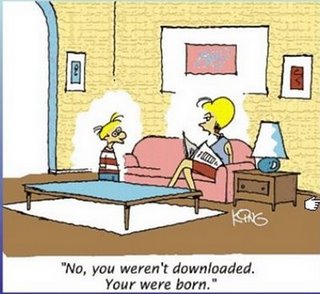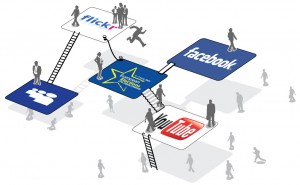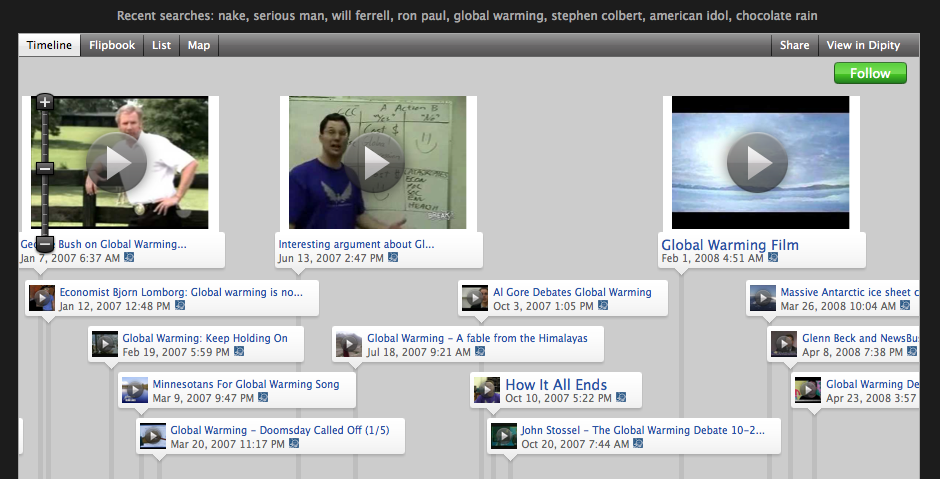E-learning concepts - Table of Content
| Site: | Tenegen |
| Course: | TC01 - E-learning Concepts |
| Book: | E-learning concepts - Table of Content |
| Printed by: | Guest user |
| Date: | Tuesday, 23 December 2025, 10:14 PM |
Description
TOC of Lecture notes, readings, exercises
Introduction - walking around
 Learning Objectives
Learning Objectives
When you have completed this session, you should be able to
• describe the concepts of the framework,
• navigate a Tenegen course.
 Introduction
Introduction
Computer based training, or education, has its roots in the 1960s. The technology was developed mainly for the training of individual trainees connected to a computer, but without any online support as we know it today.
According to Wikipedia (en.wikipedia.org/wiki/Distance_education) distance education, however, can be traced back to 1728 in Boston – a long time before the World Wide Web was devised in 1990. Though separated by many years, these technologies and methods of learning converged to produce what we call eLearning.
There is no generally accepted meaning for the term eLearning. One of the major thinkers in eLearning is Elliot Maisie, (www.masie.com), his definition is:
"e-Learning is the use of network technology to design, deliver, select, administer, and extend learning".
Within the European Commission's eLearning Initiative (Full factsheet - europa.eu), eLearning is defined as:
"eLearning means using the new multimedia technologies and the internet to improve the quality of learning".
Bringing these together we can define eLearning as:
eLearning is the use of new media and network technologies to design, select administer and extend learning thereby improving its quality.
With the development of the collaborative and social technologies of Web 2.0, it became possible to implement collaborative technology enhanced learning. This is some times called eLearning 2.0. However, in this environment we shall use the term Technology Enhanced Learning – TEL.
There are some important questions that should be asked of these approaches:
• What do these technologies offer to a teacher?
• Are these technologies just for games and entertainment?
• Or, do these technologies offer students a real opportunity for learning?
• Can these technologies improve learning for students?
• What does today’s school generation expect from us?
• How can the web technology help?
Let us look for the answers together!
For example you may never actually meet your tutor. Instead you will almost certainly ‘meet’ him/her in the learning environment meeting places – the forums. Agora is a computer based forum used in Moodle as part of our chosen learning environment. You will see messages posted regularly on Agora, and similarly your tutor will read posts from students there too.
Visit and read tutor posts on the forum by clicking on the word "Agora“!
Moodle
Right now we are in the middle of an e-learning environment. In this case it is Moodle – a popular Open Systems learning environment. You have logged on as a student. Look around! Press buttons and follow links and see what happens. Note the variety of functions that are available to you and do not worry about getting lost, you can always start again.You may find it difficult to navigate from place to place at first, but it will become easy to navigate around with practice.
When you read these pages, you will sometime see words with blue letters, underlined. These are called active links and they are linked to the on-line glossary. If you use your mouse to ‘click’ on the text, you will be navigated to the glossary, where you can find out the meaning of the words.
I have tried to describe the functions and features of Moodle in the following diagram.

From the picture, you can see that we have many of the things you had at school.
• There are books.
• There are assignments. You have to complete these assignments within a deadline, just as you did at school.
• At school, teachers stored equipment and tools which they would use in their lessons in the classroom. In our laboratory, we store digital learning tools. Tools such as videos, games, dictionaries and glossaries, and tools which we can use for on-line practice.
The e-learning environment – Moodle in our case – is often referred as a “virtual classroom.” Perhaps you can begin to see why, though this analogy is not quite correct. You rarely get lost in a classroom, for example. Here, it may feel unfamiliar to access these gadgets by clicking on a mouse button.
However, since there are so many options for you to choose from, and as each option may lead to another, you may find it quite easy to get lost here. Don’t worry – this is the same for all of us when we first meet a new computer based environment. You will soon become familiar with navigating around our virtual classroom.
 Modules
Modules
The Tenegen course is broken down into a series of modules. The list of modules is presented in the home page for this course, basically as a list of names. To access any one of these modules, click on its name.
Each module is broken down into a sequence of Sessions each of which will take you about 15 to 30 minutes to study.
In every module you will find a general description along with the basic figures in the module. This description contains the learning objectives and outcomes, and the credited and unaccredited assignments you have to fulfill. The basic content for the session is presented as a series of learning objects. There are various types of learning objects: explanations and course notes, other readings, and exercises to re-inforce your learning.
 Laboratory
Laboratory
The icon for the laboratory is in the middle of the home page. However, the learning tools within the laboratory can also be accessed from the left side panel within each module. This use of navigational blocks is commonplace in Moodle. Tools in the laboratory are also available within all modules. The tools of the laboratory include: video tutorials, games for practicing, a repository of learning objects, and several other tools to assist your learning.
 Communication tool
Communication tool
In this course each and every one of us are both teachers and learners. We all learn from each other. The teacher can be the learner; the learner can be the teacher.
Learning is a social exercise, and is based on human-to-human communications. In the Tenegen communications suite, we have access to: the Agora Forum, Group Fora, Webinars, Skype, email, and blogs. We use these tools to share knowledge and skills.
 How do you find your way back?
How do you find your way back?
The learning environment can be roamed in all directions, and you may find this confusing enough to get lost. There are several ways to find out how to return to where you came form, or how to get to another part of the environment.
a) The easiest way is to use the ‘Back’ button (at the top left) of the browser, though it is not always advisable in Moodle. Sometimes there are too many “steps” needed to take you back to where you want to be.
b) There is a ‘navigation bar’ in the upper left corner of the Moodle window that maintains a trail of how you got to the current position. These are often called ‘breadcrumbs’. By clicking on the items in the trail you can quickly get back to a chosen point.
Example:
Here we have navigated to a game, named "crossword":
Here we are just looking for one of the self assessment questionnaires:
![]()
So to navigate back to the module TC01 home page, simply click on the TC01 entry.
c) Sometimes the function that you asked for with your mouse click will appear in a new window. In this case you should simply close the window after reading the content that you wanted.
d) Finally, ‘Home’ always helps!
 Exercises
Exercises
1. Study the section of the learning guide called Sending a message.
2. Send a short message to your tutor, following the steps outlined in the study guide. You may also try and use the navigation bar to do this. Your tutor is waiting for you message and will promise to answer it.
4. Access the Laboratory. Browse the videos, and then come back to here! How? Click here on the word after the colon: Videos!
3. When you see a word in the course highlighted in blue it may be included in the Glossary. When you move the cursor (mouse pointer) over such a word and click it, a new window opens. The new window will contain the meaning of the word. Try this feature out. Browse the glossary. Find the expression “Moodle” then return here!
Learning Environment
 Learning Objectives
Learning Objectives
When you have completed this session, you should be able to
• describe the concepts of the framework,
• navigate a Tenegen course.
 Information desks in Moodle
Information desks in Moodle
The various ‘blocks’ within our e-learning environment (the item blocks that appear on the left and right hand sides at times) offer several tools and options for students and teachers to assist their learning. Here are a few of these:
Other modules in this series (specifically the module on Setting up a Moodle course) you will become acquainted with all these tools as an administrator, rather than just a student. In these later modules, you will be asked to create your own Moodle based course. For the present, though, take a look at those that are essential for orientation within the environment.
The structure of the front page of the Moodle environment is very flexible. This course instance has been designed by Tenegen teachers and the Moodle system operator. This basic layout is deliberately repeated on the front page of each course and module, but there can be variation within the course if it is required.
Course developers choose the tools and information services considered to be important for the particular learning approach taken. This is why there is not just a single internal structure for every course.
The flexibility of Moodle allows us to consider aesthetics and pedagogy together and offer a substantial amount of flexibility. Though the layout of the main Moodle window can be structured much as you wish, the convention is to divide the Moodle window into two or three component parts.
1. On the front page the courses and the list of categories usually appear in the center panel – the main panel.
2. Information desks (the blocks) appear on the right and left sides of the window – perhaps only on one side.
After selecting a particular course, the actual lessons, exercises and other learning elements can be selected by clicking on these objects.
| Lists of the courses (modules) in the center of the front page | Contents, exercises, assignments, all what you see on the middle part of the window, after entering a course |
 |
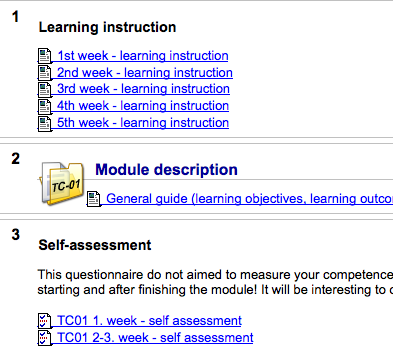 |
The blocks on the right and left side of the window help you to navigate and to find the latest information.
Sometimes we say ‘module’ and sometimes ‘course’. It is important to know that in the Moodle terminology the course is a complex learning entity. In a Moodle course, all the components required by the student are collected together into the environment. These include learning materials, assignments, tests, discussions and so on. So in a Moodle course, these components are linked together to form a single, well defined learning process.
In general educational use, the word module has much the same meaning. In Tenegen ‘module’ and ‘course’ are synonymous.
Information blocks in TC01
In a learning environment it should be easy to find out which students are on-line, what messages are waiting for you, and what is scheduled next. This information is generally assembled as part of the sign-in process.
| Who are present? | New messages for me? No! | Participants |
What next? |
 |
 |
 |
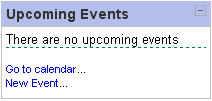 |
You can access each information desk (block) with a simple mouse click. In the example above this can be to access the profile of the given person, a new message, the list of participants, or the description of the actual exercise.
As well as people and messages, we have access to a series of icons which lets us use particular tools to support our learning.
| Next events |
Resources, activities | Virtual conference | Shortcuts to access tools |
 |
 |

|
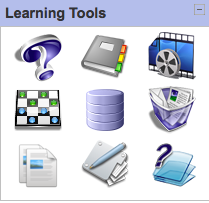 |
The events calendar shows that there is an event planned for the 2nd February. After clicking on the cell for 2nd February, you can check what the event is.
If you click on ‘Assignments’, you will get access to a list of all assignments for this module. If the tutor invites you to a video conference, you can join with the ‘Conference room’ desk. Finally, in the ‘Learning tools’ block on the right, there are icons to navigate you directly to the services stored in the laboratory. Each icon is a hyperlink to a specific service.
In the Setting up a Moodle course module, you will develop the knowledge necessary to construct such information desks. It does not take long to do this, because of the simplicity of using the support services in Moodle.
 Excersises
Excersises
1. Logon to Tenegen, and then locate the blocks on the home page.
2. Use the correct link to navigate to the main page of module TC01.
3. Open the links on each page visited and note what they do.
4. Record your notes on your learning diary. If you are not sure how to do this, visit the tutorial: " How to write blogs in Moodle " !
Creativity? (forum, diary)
 Learning Objectives
Learning Objectives
When you have completed this session, you should be able to
• create a blogpost,
• visit the forum and
• reflect on questions raised in the readings.
 Reading
Reading
Sir Ken Robinson - an internationally recognized expert in culture and education says "We are educating people out of their creativity", and he claims a radical rethink is needed for our school systems.
Please listen to his enjoyable and rather provocative presentation (from 2006) on the TED portal by clicking the "Play" button on the navigation bar! (Choose subtitles for your language before starting the video!)
If you would like to know more about Sir Ken Robinson, visit his web site: www.sirkenrobinson.com
Here are some pictures from a Hungarian vocational school (Krúdy Gyula Secondary School, Hungary):
 |
 |
 |
 |
These pictures show unusual feature in the curriculum! Is this an exceptional school?
 Exercises
Exercises
![]() 1. Attend the Discussion on Agora, on the subject “Are the educational methods we use suitable for developing creativity and can e-learning help?” The red and blue character figures will navigate you there!
1. Attend the Discussion on Agora, on the subject “Are the educational methods we use suitable for developing creativity and can e-learning help?” The red and blue character figures will navigate you there!
2. Open your learning diary and write a short note about your experiences.
3. Csikszentmihalyi said that “It is not that students cannot learn, it is that they do not wish to…if educators invested a fraction of the energy on stimulating the students’ enjoyment of learning that they now spend in trying to transmit information we could achieve much better results” (Csikszentmihalyi, 1991, p. 1). Write a report discussing the issues in this quotation in your learning diary!
Remark: if you have already your own blog on the net, you are free to use that one as a learning diary. If you do not have such a blog, but you would like to create one for yourself, please see the "Google Blogger" book in the TC01 module. It will help you through the processes of how to create and manage a blog!
References
1. TED (Technology, Entertainment, Design - www.ted.com) is a nonprofit organization, established in 1984 with the purpose to publish thoughts worth for listening to, ideas, and introduce people who should be paid attention on. Videos can be subtitled and thanks to some enthusiastic colleagues there are more and more videos subtitled in different languages.
2. Csikszentmihalyi, M. (1991). New Horizons for Learning. Retrieved October 1, 2008, from New Horizons for Learning: http://education.jhu.edu/PD/newhorizons/future/creating_the_future/crfut_csikszent.cfm
Learning tools
 Learning Objectives
Learning Objectives
When you have completed this session, you should be able to
• Access all learning content in each module.
• Locate assignments
• Execute assignments.
 Reading
Reading
All learning tools for each module are collected in Moodle into one technical are called a ‘course’. The ‘course’ consists of all the content, exercises, tests, etc. which assist learning. If you select the "TC01 - E-learning concepts" module on the front page, you will navigate to the module elements and you can choose to read the learning content, do the exercises, upload an assignment within the stated deadline, etc.
 Module description
Module description 
In these documents you find important information about the module. These are worth reading through it once. The short summary of the whole course, the modules and the assignment can be accessed by the icons in the block "Course information" published on the left side front page.
 Self-assessment
Self-assessment
One of the key features of an e-learning course is the provision of self-assessment. To reflect this importance, when you carry out a self-assessment exercise, your results will be recorded in your learning log. If you want to see the results of your study, and hence get some measure of how your knowledge is improving, it is worthwhile doing the tests several times and so that you can compare you results against earlier ones.
 Lecture notes, readings, exercises
Lecture notes, readings, exercises
Lecture Notes, Readings and Exercises are contained in the "Moodle book" Feature. This book contains the learning materials for the whole course, along with guidelines, exercises, and various other tasks.
 Credited assignments
Credited assignments
These are descriptions of the credited assignments, which you have to fulfill within a given deadline. It is not necessary to complete an assignment in a single session. You may complete it over a series of sessions, but it should be completed before the deadline ends of course.
You can access the credited assignments from several places inside the learning environment, and you should take note of the deadlines. Deadlines outlined in red are important – click the red colored cell and you will be navigated to the task you have to fulfill.
To learn details how to submit the assignment see the section in the learning guide!
 Credit test
Credit test
On-Line tests are automatically evaluated by the assessment engine in the learning environment – Moodle. These are effective and efficient mechanisms for the teachers to assess students, partly as it saves them from the duty of correcting them. These tests can be repeated several times, if desired, and Moodle can be set to save all of, or just the best, results. These are settings that teachers can elect to change to suit the particular rubric that they feel best suits their course.
 Feedback
Feedback
One of the major advantages offered by an e-learning environment is the potential for all participants to communicate with each other. This can be used well to provide course feedback. For a teacher, feedback is an important means of knowing how to continually improve a course. For the learner, too, critiquing the course details requires them to develop a deep understanding of the knowledge underpinning the course.
Future learners gain the benefit of these discussions. They inherit the best of practice in the course.
All learners, then, should give their opinion as to the quality of the educational content and of the quality of support from the tutors. Such feedback should be completed by the end of the module.
Other Activities
At the end of the lesson you may find other tasks.
 Exercises
Exercises
1. Locate the credited assignment TC01A01. Complete this exercise by entering your impressions about your first experience of Moodle.
2. Locate and complete the first self-assessment questionnaire.
3. Find the short description of courses and modules and read through them please! Discuss these aspects of the course in your learning diary.
4. Find the detailed description of the TC01 module, read it through and make comments on it in your learning diary!
Laboratory
 Learning Objectives
Learning Objectives
When you have completed this session, you should be able to
• add a new entry into the glossary,
• use the help desk to look around the laboratory in order to access the learning and practice tools
• learn through play on the net  !
!
 Glossary
Glossary
The glossary is a lexicon of 21st century e-learning concepts. The words and expressions, used within our texts, appear as hyperlinks and their meanings and further explanation can be found with just one click.
The glossary can be continuously extended and all participants, learners and tutors can participate in the work of extending the glossary. It is instructive to try to add a new entry to the glossary. However, when adding a new entry all participants should observe some simple procedures, particularly as some of the games require an icon for every concept within the glossary.
• If you insert a new glossary record, upload an image and a link to its source as well.
• Any image should be about 400 by 600 pixels (width and height) – not too big, not too small.
• It is also important that the word being defined is not used within its definition. In some games the definition is shown and the expression or word must be entered by the player.
• The definition does not necessarily have to be your own words, but if you cite, the source must be indicated
 Games
Games
The games built into Moodle are simple and friendly. They are useful for practice and for having fun while learning. Most are based on glossary entries, so the more entries in the glossary, the more interesting the games will be.
 Video tutorial
Video tutorial
The video tutorials are downloadable presentations on topics of interest to learners. The presentations may help you to use the technical tools in the learning environment and on the Internet. The tutorials provide an additional channel for learning support, without the need for tutor mediation. Try them out, and see if they suit your style of learning.  Learning guide - help
Learning guide - help
The Help system is there to aid your learning and to help with your use of the system. Help is context sensitive – the link will take you directly to the support entry relevant to that situation.
The navigation of the Help system is similar to that of the Glossary system
 Repository of Learning objects
Repository of Learning objects
The Repository is a collection of e-learning elements (videos, pictures, exercises), which may be freely used in the development of a course. The objects in the Repository have no fixed format and they range in size from small to large. As with the Glossary, all members of the community can extend the collection.
Be aware of the value of the repository, and as you browse the web, you may come across interesting items which may be of value to others if added to the Repository. Participants are encouraged to extend the collection with their own work. How to do this is covered later in this course.
 Editorial
Editorial
Tenegen is an open environment; it is accepted that all elements might create debate so ideas are welcome from learners and tutors alike. Any comment about the course can be given through the Editorial feature. Module authors want to hear your opinions – whether commendation or criticism. The module authors will be happy to hear your opinions. Do not hesitate! We accept all commendations and criticisms!
 Bookmarks
Bookmarks
Bookmarks are important in e-learning. Since most learners will start and stop learning events without necessarily completing them, it is valuable to be able to return to the place where learning left off. This is made easy with bookmarks.
All the important and useful web links related to Tenegen modules are collected here described with keywords. We have incorporated a web application called ‘delicious’ – a so-called ‘social bookmarking tool’ – for sharing links with others (see delicious.com ). Its use will be covered later.
 Students on the Net
Students on the Net
One of the module goals is to understand more about how students access the web. There is a questionnaire to solicit answers to the question: “what do students do when they are on the web.” Complete of the questionnaire is an activity in a later section.
 Publications
Publications
This is a collection of relevant publications from members of our community. The publications are generally in the form of writings and presentations related to course topics.
Students can upload their own publications, to be shared with the rest of the Community.
 Exercises
Exercises
1. Log in to www.wikipedia.org, and search for an interesting e-learning concept which does not appear in the glossary.
2. Create a new entry in the glossary for this concept. Remember to cite the source for the concept. It is not necessary to upload an image, but try to find a relevant one. To upload a new entry, follow this hyperlink: Add new entry into the glossary!
3. Visit the Editorial, and make some comments on this session! Were all the explanations good enough for your understanding?
E-learning
 Learning Objectives
Learning Objectives
When you have completed this session, you should be able to
• Describe the differences between e-learning 1.0 and e-learning 2.0,• compare functionality of Moodle with a requirements definition for an e-learning system.
e-Learning Systems
Computer Based Training (CBT ) is not a new idea. In 1967 – more than 40 years ago – the US Computing Report magazine [1] reported that astronauts who participated in Apollo mission practiced first on simulators before undertaking the task they had to accomplish in reality. In the 60s computer controlled simulator programs were also used to train civil and air force pilots.
Even in those days, teachers were worried about students spending too much time in front of the computers. Anthony Oettinger, Professor of Harvard University, expressed his thoughts in 1967 as “They are not afraid of computers at all. All the more the problem is, rather, how to save them from becoming hostages of the computer.”
The widespread use of Internet and the improvements of multimedia systems have made educational applications more dynamic. By early 90s CBT migrated into today’s e-learning. In 2004 e-learning 2.0 became a major focus and nowadays there is even mention of e-learning 3.0.
According to the most widely used definition e-learning is an ![]() educational form that uses the tools of information and communication technology (ICT) for improving the efficiency of education and training.
educational form that uses the tools of information and communication technology (ICT) for improving the efficiency of education and training.
The table below describes the most important stages of e-learning development.
As with computer generations, timing definitions are approximate. However the demarcation line between e-learning 1.0 and e-learning 2.0 is unusually clear. In e-learning 1.0 system students read, listen and adopt. They have limited options for interactivity, except in the area of simulations, or multiuser games. In the era of e-learning 2.0 there are innumerable tools to generate interactivity, for exchanging and sharing knowledge through the internet. Self-organized learning communities are also now rapidly developing, where there is a blurring of the difference between ‘teachers’ and ‘students’.
The golden age of e-learning systems (the LMS and LCMS type systems) lasted from the early 90s until the Web 2.0 tools started to appear. Many people predict that the age of strictly teacher centric ‘virtual schools’ may be over. In fact more and more educational institutions now create their own e-learning systems. Moodle is a good example of this type of framework being used, with more than 47,000 validated sites in more than 208 countries (moodle.org/stats/) in 2010. While in the 90s development tended to represent a huge amount of capital finance for institutions, in the era of 2.0 capital cost-free solutions are becoming commonplace.
It appears that many institutions are adopting systems which tend to incorporate e-learning 2.0 systems.
The characteristics that an e-learning 2.0 system exhibit are as follows:
Openness:
1. Learning environments should not create a closed ‘isolated system’. They should be open to, and interoperable with, other systems and solutions.
Participation:
2. Teachers and students should cooperate in the development of the environment. Students should have the option to integrate external tools used by them. Teachers and students should work on the same platform with the same tools. Students should get the opportunity to create and share new lessons.
3. Participants should be able to tag their own contents freely. They should be able to develop their own taxonomy reflecting those parts of lessons which interest them most.
Motivation:
4. Learning environments should support participative activity in a user-friendly manner.
5. Learning environments should support developing communities, and should provide options for participants to get to know each other.
6. Teachers should be present in the learning environment. In addition to creating study materials they should emphasize organizing conversations and exchanging experiences
Tracking, evaluations, feed back:
7. Teachers/Administrators should have the functionality to track the learning of individual participants.
8. Teachers/Administrators should provide options for feed back.
9. e-Learning systems should provide functionality participants to reflect on their learning.
10. Learners should have the option to express their opinions about the content offered.
 Exercise
Exercise
1. Based on your experience in the Tenegen learning environment, write a report in your learning diary, on how well this environment meets the requirements listed above for eLearning 2.0.
2. Find an online resource on the web which could help other students in their learning. Write your suggestion into your learning diary!
References
1. Frederic G. Withington: The Real Computer: Its Influence, Uses and Effects, Addison-Wesley Publishing Company, 1969)
2. Ingo Blees and Marc Rittberger: Web 2.0 Learning Environment: Concept, Implementation, Evaluation, German Institute for International Educational Research (eLearning Papers • www.elearningpapers.eu • 1 Nº 15 • June 2009 • ISSN 1887-1542)
3. Bryan Holmes, John Gardner: E-learning - Concept and Practice,SAGE Publications, London, Thousand Oaks, New Delhi, 2006.
utopia?
 Learning Objectives
Learning Objectives
When you have completed this session, you should be able to
• Describe the changes which have happened in communications technologies over the past ten year,
• Register as an "online tutor",
• Describe alternative mechanisms for the application of copyrights.
Technological Forecasts
Communications
In November 1992 (15 years ago!), Scientific American published a special issue on communication, computers and networks [1]. Here is a quotation from the article by Michael L. Dertouzos, employee of MITI. The author predicted that:
|
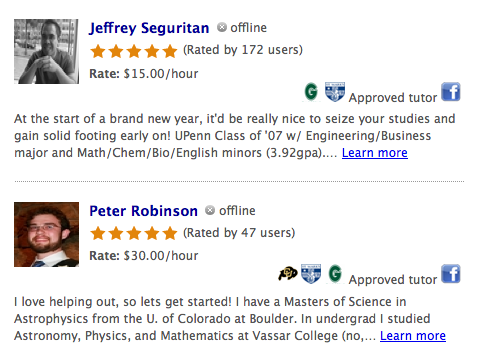 |
In 1992, then, this scenario seemed to be a utopia; today it is almost reality
According to researchers, the social effects of this change can only be compared to Gutenberg’s innovation of printing. Book printing made possible the accumulation and distribution of human knowledge on an industrial scale. Will the information age predict the end of the Gutenberg-Galaxy (https://en.wikipedia.org/wiki/The_Gutenberg_Galaxy)? This prospect, for many of us who were raised in the 20th century, does not seem to be so welcome.
History however may provide some peace of mind. On many occasions there has been the expectation of quick, and life-changing, benefits from various technical inventions. However over time, and after the early elation is over, there has been a realization that transformational change would take more time. The Japanese, for example, developed and published an information strategy in 1980 in which they defined innovations for the following ten years. Among these plans there were machine translation systems for spoken languages, solutions for speech recognition, and a 5th generation computer system with human-like artificial intelligence. After 30 years we are still waiting for truly intelligent, problem solving computers.
e-Learning Tutors
| At the portal at www.ziizoo.com different tutors are wanted for different subjects. After selecting a subject, a list of the teacher candidates is received. If he/she is available then contact can be made. After a short introduction, information can be received about the price of his/her lessons, the number of his/her students and about how his/her methods, teaching is evaluated by the students |
Information Society
In the information society, knowledge can become outdated very quickly. As learning is such a basic lifelong, requirement, information becomes an asset. Those who will produce and distribute information will exercise power.
E-business
Direct contacts can be established between the participants of an economy (purchasers - sellers, employers – employees, banks – clients) regardless of the distance. Electronic business (e-business) and remote working via Internet is expanding.
E-government
Recent regulations from ministries and governments can be readily posted to the Internet. More and more civic administration functions are based on the web. Citizens communicate via Internet with government agencies for taxation purposes, applications for higher educational institutions, applications for identification card, etc.
Everyday life
New technology is present everywhere in daily life. Households are ‘automated’ (automatic gates, monitoring and alarming systems, ovens operated by timers, etc.) as well as our personal administration (mobile banks, bankcard automats, job hunting on the net, buying theatre tickets, etc.). Traditional correspondence has in many cases been replaced by e-mail. Keeping contact with acquaintances who live abroad is now arguably best done via computers and Internet. Using software (e.g. Windows Messenger) we are able to transmit live pictures and voices – something not possible by telephone.
Copyright
However protecting copyright is becoming more and more difficult as the world becoming more electronic. Illegal distribution of music CDs, films, software, causes serious problems throughout the world.
There are alternatives to copyright protection though; it is possible to donate your rights to the world, while protecting it from exploitation by individuals and corporations.
"A Creative Commons License" is a license created by an American nonprofit institution which offers such a new alternative. Instead of using strict, and difficult to enforce, legal systems it provides the potential for creators to offer their products to others with some self-determined limitations.
creativecommons.org
Creators can select the suitable CC category on a web page and so determines this way with what conditions will it be permitted to use the product. One of these types of CC categories is Attribution Share Alike. Look at the image below:

Culture, Science
More and more libraries, museums, art galleries present their collection on the worldwide web. News, TV programs, music, films can all be accessed through the Internet.
More and more universities and collages make their syllabuses and lessons public on the Internet and there is no limitation for getting a “real” degree in the virtual space of some American universities (provided that we speak English well enough and can pay for the tuition).
 Exercise
Exercise
1. Visit the web site of www.ziizoo.com. Would it be a good idea to create some service like this in your area? Would you participate in it, for example by taking students on over the web? Write a report on this web site in your learning diary.
2. What do you think of Creative Commons – would you be likely to apply it to your own intellectual property? If we had a common online lesson database would you publish your own tools with some of the “Share alike" licenses? Has your country already joined Creative Commons (see creativecommons.org). Write a report on CC in your learning diary!
References
1. Scientific American, November Special Issue “Communication, Computers and Networks”, 1992.
and ICT
 Learning Objectives
Learning Objectives
When you have completed this session, you should be able to
- describe the different stages of e-learning’s technical evolution,
- identify the effects of ‘technological convergence’ in your own teaching practice.
 Reading
Reading
The generation born after 1980 is sometimes called the net generation – the digital natives. They are the first generation to become adults in the information society. They know the underpinning technology of the information society in an almost sub-conscious way.
What does ICT mean?
The acronym is made of the initials of "information and communication technology" or, more simply, info-communication technology. What is behind the evolution of this concept?
Technological convergence, globalization
Sociologists have termed the 20th century the age of technological convergence and globalization. Earlier analogue technology was gradually replaced by an era based on digital technology. Digital video and television have appeared in recent years, for example, and analogue telephone lines have been slowly replaced by digital solutions. [2]
Due to digitization the industrial sectors of:
• computer technology and computerized networks,
• telecommunication (telephone, fax), and
• audiovisual appliances (TV, radio, entertaining appliances).
are gradually merging.
This is called technological convergence . Mobile phones can be used for taking pictures, listening to music. With small communications devices we can connect to the Internet, and via Internet we can watch TV, listen to the radio and phone…
The development of communication technology
|
Computers with the Neumann-principles (1940-1955)
|
Second and third generation computers (1960-1980)
The fourth generation computer system was made possible by the application of VLSI (Very Large Scale Integration). In 1971, INTEL created the first micro-processor: a few thousand active circuit units executing all the essential functions in one chip. In 1981 IBM presented the PC (Personal Computer) based on the Intel 8088. |
The improvement of storage capacity
|
The development of input and output peripheriesIn the 90s the mouse appeared as an input tool. It seems to be insignificant but in fact, when considering the everyday work done by computers, it was a very significant change. The first impact printers were followed by high-speed laser printers and multi-function office equipments. Cathode ray monochrome monitors were replaced by low TFT monitors. |
Computer networks
|
Multimedia
Nowadays we live in a new communication age with its enabling technology being wireless technology. Mobile phones have become universally adopted at a speed never experienced before. A new concept has become possible for the next generation of e-learning – ‘m-learning’ or ‘mobile learning’. This is education delivered through mobile technology. [3] The information society is a world model of ‘globally’ based knowledge. It accesses the whole the history of human civilization and culture. It came into being, and expanded from, the end of the 20th century [2]. Its development, however, started in the 60s and 70s. The information society sits on an economy based on know-how, where information has become an asset. High quality technical investments and constantly upgraded information technology requires “lifelong learning” for the citizens of this society and so the problem of renewing our educational systems comes sharply into focus. |
 Exercises
Exercises
1. Design a survey for your fellow students. The survey is to determine when they first came across the terms “technological convergence" and "net generation". Write a report on the results of your survey in your learning diary.
2. Write a report entitled “The effects on education of Globalization” in your learning diary.
References:
1. Information Society, edited by Robert Pintér, Gondolat, Bp. 2008. http://netis.nyme.hu/
2. Communication World Report, 1997 ORTT, Magyar UNESCO Bizottság, Bp. 1988.
3. Desmond Keegan: Mobile Learning: the next generation of e-learning, Distance Educational Institute, 2005.
the School of Future?
 Learning Objectives
Learning Objectives
- When you have completed this session, you should be able to
- describe the different stages of e-learning’s technical evolution,
identify the effects of “technological convergence” in my own teaching practice.
 This picture on the left looks very depressing, especially for those who spent happy days in similar looking classrooms, sat at old desks like these. However maintaining the traditional ways of teaching is becoming more and more difficult.
This picture on the left looks very depressing, especially for those who spent happy days in similar looking classrooms, sat at old desks like these. However maintaining the traditional ways of teaching is becoming more and more difficult.
The information society is a carrier of a new social tension: the gap between those who can get economic positions, and those who cannot, grows wider. A digital gap can be created between the different social classes of a nation (when poor people or certain minorities fall behind) or between different economies.
In the development, or in the prevention, of a web culture, computer and Internet supply plays a prominent role, but it is not just a technological matter.
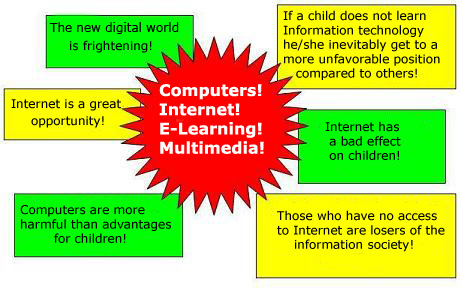 No wonder that those who have experiences from traditional educational institutions are sceptical of many issues relating to this new pedagogic era. There can be no doubt that the way knowledge is acquired in the 21st century is changing rapidly. School age pupils read fewer books than previous generations and when they need to look up something quickly, they will tend first of all to browse the World Wide Web, rather than a reference book .
No wonder that those who have experiences from traditional educational institutions are sceptical of many issues relating to this new pedagogic era. There can be no doubt that the way knowledge is acquired in the 21st century is changing rapidly. School age pupils read fewer books than previous generations and when they need to look up something quickly, they will tend first of all to browse the World Wide Web, rather than a reference book .
It appears that teachers feel that there are many drivers and barriers to the adoption of computers, the Internet, e-learning and multimedia into the teaching system. Some are shown on the picture.
The opinions can all be readily justified, and are true in very many situations. Teachers, schools, and parents in the 21st century are all faced with new challenges. Teachers not only have to face up to these drivers and barriers, but they must also support students and parents in coming to terms with these drivers and barriers.
Among young people there are now many computer addicts. This is perhaps due to the fact that children use computers in a way that designers did not expect. However many claim that computers
- adapt users to superficiality (there is no need for thinking, only for trial and error),
- make users conceited (I can use it but my parents cannot),
- generate aggressiveness; (rude games and the uncontrolled use of games).
Krajcsi (2000) collects "the old troubles od the Internet" as he calls them, and claims that "the often cited harmful mechanism that are considered to be the threats presented by the Internet are not all related to the net but rather to old dangesr which existed before and resurfaced in the Internet era".
See some examples of this:
- The question of reliability: you cannot know who is at the other end of the communication channel.
- Authenticiy: to what extent can we trust the information from the Internet?
- The loss of sense of reality: those spendign too much time online, lose contact with reality.
- Alienation: those addicted to the computer gradually lose their relationships with other people.
- There is a loss of identity: you can become whoever or whatever you want on the Internet as a result of which you yourself no longer know who you actually are.
- Agression: computer games are alien to human life and make their users violent.
- The appearance of extremes: pornography and paedophilia; the Internet is the favourite gathering point for men of unnatural inclinations and extremist beliefs.
- Communication becomes impoverished: the potentials of the new means of interaction result in the loss of vibrant communicative practices so that language becomes stunted.
- Data smog: the abundance of information overwehlms the users since there is no of finding one's way through the mass of data.
"However, there is nothing mystical about the Internet. It is exactly the same as the world that surrounds it, a claim that can be easily justified since the world is also violent, certain people are evil, and sexuality appears considerably in our every day lifes as well. The world is reflected in the contents of the Internet and its usage...We should not disregard the fact that there is nothing else on the Internet, but uploaded content that had existed in the real world beforehand, it is nothing less, nothing more." (2)
Children can be immersed in the use of computers; developing personalities which exist only online, spending many hours in single user and multi-user games. But what do many teachers and parents know about computer games, and immersive environments? How does computer-based gaming affect our children? Are there any good effects from playing computer games? Parents buy computers because they feel they should provide their children what they think they need.
The ideal position is where computers and Internet are more than just for amusement for students and additional work for teachers. To get to this position, e-learning has to become a more efficient and more realistic tool for everyday teaching. There is also a need for more learning opportunities for teachers and in the development of new methods of teaching and learning.
IT infrastructure in domestic educational institutions has significantly improved over the past few years. However, a survey from 2006 about the “application of e-learning syllabuses for vocational training” shows that most secondary schools were only able to create proper computerized classrooms to teach information technology itself. Usually there are few options for teaching traditional subjects in computerized classrooms. There is still a need for further improvements in this area.
Is e-learning really the future of the school?
The development of networks and the Internet, and the numerous new tools, have started a new age in learning. It has become clear that not only must new learning concepts be defined but everything that we know about pedagogy, methodology, schools, students, and teachers, must be reconsidered and rebuilt if necessary.
Of course, it is impossible to digitize those centuries’ old, very reputable systems of learning overnight. Would we want to? The web has taught us not to design a command economy model for anything, especially social activities such as teaching and learning.
But can we afford to ignore the possibilities offered by the information age? Is it possible that teachers can keep control in the digital world without the knowledge and resources that the web provides?
If the use of e-learning methods is a possible way of reviving pedagogy, this poses the question: “Do we have enough resources for implementing e-learning within our school”?
- Are there enough computers in schools?
- Is there a fast enough Internet connection?
- Are there enough good quality resources, learning materials on the web?
- Are teachers well enough prepared and motivated to use e-learning methods?
 Exercises
Exercises
- Write a report, in your learning diary, discussing the following idea. “The potential where anyone can publish his / her thoughts, and can take the opportunity to participate in the development of a scientific terminology really leads to the destruction of science?”
- Can students be involved in the development of syllabuses or lessons? Write your ideas and arguments on this topic in your learning diary.
- Discuss these concepts in the forum? Click on this small icon (here, to the right) and it’ll take you to the forum!
References
- Krajcsi Attila: Az internettel kapcsolatos régi problémák (The old troubles od the Internet), (in Jel.KÉP, 2000/3. 3-10)
- Information Society, From Theory to Political Practice, Coursebook, Gondolat-Új Mandátum, Budapest, 2008., https://www.flickr.com/photos/tags/NETIS%20project/
versatility

 Learning Objectives
Learning Objectives
When you have completed this session, you should be able to• to categorize e-learning solutions,
• select appropriate pedagogical solutions for your own work.
 Reading
Reading
E-learning can unfortunately be made to appear to be very complex. This was true of educational CDs, and it is also the case with video conferences all the way up to broad education networks. However e-learning has different meanings for elementary schools, secondary schools, distance education, adult education, upper education, and for supporting disadvantaged students.
In many examples of computers and e-learning, we do not talk about education tools but of technology. This technology is really the entirety of tools and procedures developed for solving complex tasks. The complexity of e-learning innovation originates from the fact that even simple pedagogical and didactic goals seem be have to be realized in sophisticated technological environments
Online/offline e-learning
The concept of on-line e-learning can be determined as learning while connected to the Internet. Interactive CDs used for independent study are solutions appropriate to off-line e-learning. Another off-line solution is to install certain educational software onto an individual computer. If lessons are received via Internet even more on-line/off-line classifications are possible. When electronic content can only be accessed while being constantly on the web we can call it on-line e-learning. Streamed video presentations are typical examples of on-line e-learning, watchable only while on-line since they cannot be downloaded.
Synchronous/asynchronous solutions
This is a fairly important, and differentiating, concept in distance education.
In terms of synchronous solution; teachers and students are present in one (real or virtual) space and time. Synchronous teaching methods are when the participants are taking part in a presentation (face to face), or in classroom lessons or video conferences in virtual space, or chatting at the same time. Asynchronous solutions include, for example, consultations through Internet forums, where the message-oriented conversations can be read at different times.
Multimedia

|
"Multimedia excites eyes, ears, fingerstips, and most importantly the head" Tay Vaughan |
Multimedia plays a significant role in e-learning due to the possible simultaneous application of several (time dependent and time independent) media - images, texts, voices, animations. Multimedia is able to integrate many learning tools (VCR, tape recorders, audio disks, etc.), and with the appropriate software, multimedia can be used to create interactive lessons from given knowledge.
Technology advances means that there are increasingly fewer limitations in respect of creativity for multimedia applications. The only question is: are we able to make the technology serve educational goals and can it be used appropriately?
Multimedia has stood at the center of e-learning solutions for the past decade. Interactivity is much enhanced with multimedia, and in the era of e-learning 2.0 the concept of interactivity has become even broader. It is also becoming easier to use and is no longer the its early privileged status among other educational mediums.
 Exercises
Exercises
1. The online multimedia “storyteller” was made for British children on the www.mrsp.com/ portal. Books selected from this shelf are read by a famous British actress. This is not strictly real "multi-media”, as children really just listen to the voice. The long reading passages are only interrupted with a few pictorial presentations. In addition to listening to fables, children can choose from a number of little games. Browse this site. Are any of the resources appropriate to be used in English language teaching and, if so, in what way? Visit the page and write a few words about it in your learning diary!
2. Teachers spend time with children all day long at school. Would it make sense if teachers met them on the Internet too with the aim of teaching/learning (synchronous way)? As a teacher, do you sometimes use asynchronous e-learning methods? For example, do you point to interesting YouTube videos and ask for views to be submitted by e-mail? Write down some of your ideas in your diary!
platforms
 Learning Objectives
Learning Objectives
When you have completed this session, you should be able to
- list the optional features of an e-learning management system,
- compare and contrast off-line and on-line e-learning systems,
- define the acronyms LMS and LCMS,
- evaluate the pedagogical value of e-learning systems,
- list the tasks of the teacher when working in an e-learning system.
e-learning Platforms
There is a wide range of e-learning platforms (sometimes called Virtual Learning Environments or VLEs) on offer to users. These platforms deliver a range of complexity and versatility in their functions and services. Looking at the feature sets it is easily possible to consider an educational multimedia CD and Moodle platform as different types of e-learning solutions, as both are specific software applications. However at a first level, different e-learning systems must meet the same requirements as any other software, such as:
- providing stable and reliable operation,
- providing a comfortable, user friendly interface which complies with all relevant legislation in respect of accessibility and ergonomic requirements.
- offering tools for following and recording the users' activities,
- managing authority and authentication,
- compatibility with the host computer environment,
- minimizing system requirements for operation,
- easy installation,
- on-line user support,
- options to refresh software and contents,
- offering productivity support.
The most basic services of educational software are:
- to present learning material delivered in different forms and formats,
- to give support to users in their exercises and their practice with the delivered knowledge,
- to assess the results of the learning process and to give feedback for the learner.
Early off-line educational programs (the products of first-generation e-learning such as CBT) actually achieved many of the above requirements. However Multimedia CDs may have looked impressive but the content was very static in the sense that its content could be difficult, or impossible, to refresh or update. The single user, multimedia approach reflected a traditional, rigorous educational approach: to deliver, to strengthen and to evaluate the knowledge acquired by the student. Creating multimedia experiences can be similar in ways to creating a traditional educational movie.
It is difficult to find many examples of high quality productions where multimedia CDs actually achieved the targeted pedagogical objectives. However there are obviously some exceptions, for example many schools use "Tell Me More" – a language teaching series, which was introduced at schools several years ago.
Interactivity is a standard requirement for off-line systems. It be can easily achieved technically (at the software level) because even a mouse click means interactivity. However, achieving interactivity which supports real pedagogical objectives can be very difficult.
On-line platforms operating on the Internet are second generation computer based learning innovations and can be classified as e-learning 1.0.
Such traditional learning environments are usually developed to operate over a computer network. The learning system may also integrate some institutional services such as student enrollment or examination. Services can be categorized in two major groups:
- supporting the learning process and the administrative work related to learning,
- supporting content authoring (creating, editing and updating learning materials.
The sub-system which supports the learning process is called a Learning Management System – LMS. The tasks of LMS are:
- managing authorities, monitoring access, registration of users,
- presentation of lessons,
- managing the assessments, scheduling the students' tasks,
- providing options for practice,
- supporting the tutor’s activities
- organizing courses,
- managing enrollments,
- recording students’ activity and performance,
- managing the evaluation of the students' performances,
- producing records and statistics,
- supporting communication between teachers and students,
- supporting quality management, for example course evaluation via students' feedback.
What are the advantages of e-learning frameworks for schools? Some think that they only generate more work for teachers. However, E-learning frameworks have options that may substantially help educators’ work in the long run. For example electronically stored lessons can be saved in such way that they can be edited, renewed and used again at any time. A common repository of knowledge can be developed and built up this way. Colleagues can share their education materials, support each other and evolve into a professional community.
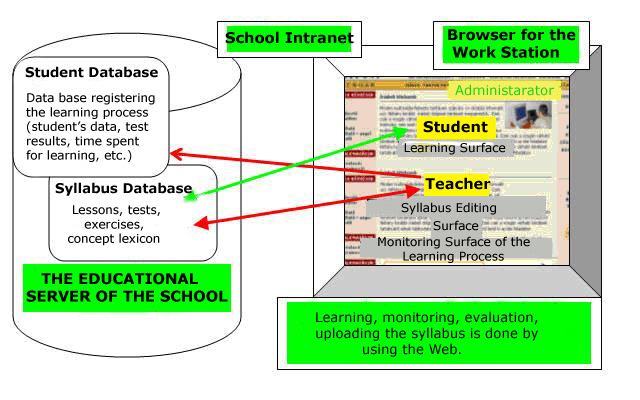
E-learning frameworks are well developed in many higher educational institutions all over the world. Lecturers upload lessons with many links to reading materials, and they can formulate requirements and manage examinations. This is the kind of framework is typically an ‘e-learning 1.0’ product – a virtual model of institutionalized education. Rigid, teacher and content focused, participants are not expected to contribute in the system. They may be only passive consumers of knowledge-based content.
In mixed systems, students can download educational contents saved on central servers to their own computers and use them without a network connection. While students are working on their own computers, data (such as test results for instance) is stored locally and when they re-connect to the network, data is uploaded to the central database (the system synchronizes local and network databases at each connection). Microsoft’s training courses operate in such a mixed system – for example the Microsoft Certified Partner program. In this example, the student is provided with a large quantity of training lessons, and the online examinations are organized (in a given country) at special, accredited examination centers.
Participants and Tasks
Tasks supported in platforms are divided between the LMS and the LCMS. What visitors to and participants in a course can actually see and what options (rights) services they can access depends on what roles and authorizations they have. Administrators have the highest position and authorization, while visitors have the lowest. The distribution of authorities is the responsibility of system administrator, but the entrance procedure and the access are supported by the platform (LMS).The LMS exempts tutors from certain administration work. They do not have to record absence, for example, and do not have to correct tests performed by students. All these are done automatically.
In Tenegen, the authors of e-learning content are called instructors. Teachers who help and supervise students are tutors. These new titles reflect the non-traditional roles they have to fulfill. For example, instructors plan student activities and they are responsible for the professional relevance and validity of the course content.
It does not matter whether we talk about distance learning or full-time courses, the role of teachers (the tutor) is crucial. Before thinking of ICT as some kind of network technology that reduces the work of teachers, consider what kind of tasks they have in an online course:
- learning objectives must be considered, syllabuses and exercises must be planned according to the goals,
- lessons, exercises and tests must be prepared and uploaded in advance,
- student activities must be planned and organized in the given LMS,
- constant presence is required! Student activities must be followed up and evaluated individually. For every little action there must be some reaction (otherwise motivation is lost).
In this kind of environment it is possible for the tutor to have to support each student individually. This is not normally possible in a real-space classroom. However, such activity can take a tremendous amount of time! It has proved a real challenge to find a business model which supports such a level of activity. Who will pay for such support?
Communication and Cooperation
In contrast to offline solutions, the great advantage of e-learning frameworks on the Internet is that there is the potential for communication and cooperation amongst participants. The “classic” communication opportunities are:
- e-mailing,
- chatting,
- forum , and
- video conference.
This list will rapidly become longer as web technology (web 2.0 and the future semantic web) develops.
Finally...
The development of framework systems began in the 90s. First solutions are often criticized because they do not do anything but preserve the bad practices of traditional teaching within a modern technological environment. Such solutions have not become, or allowed to become, obsolete because as long as institutions based on today’s system survive, the functions which support will also survive.On the other hand, and more importantly, modern frameworks are much more open than earlier ones. They tend to support cooperation and try to integrate the latest tools from web 2.0 technology. Moodle is an example of a web2.0 aware platform.
 Exercises
Exercises
- Write a report in your learning diary on the possibility of implementing an e-learning framework in a secondary school. Discuss the potential benefits of all schools having their own e-learning framework. Would you be likely to use such a system? Could you include children in the common innovations of a framework?
The figure below show a schematic of an online e-learning framework.
solutions
 Learning Objectives
Learning Objectives
When you have completed this session, you should be able to
- list a range of worldwide used solutions for LMS and LCMS systems
- list the main features of one of the open source LMS systems – Moodle
There are a large number of framework solutions available for implementing electronic learning environments.
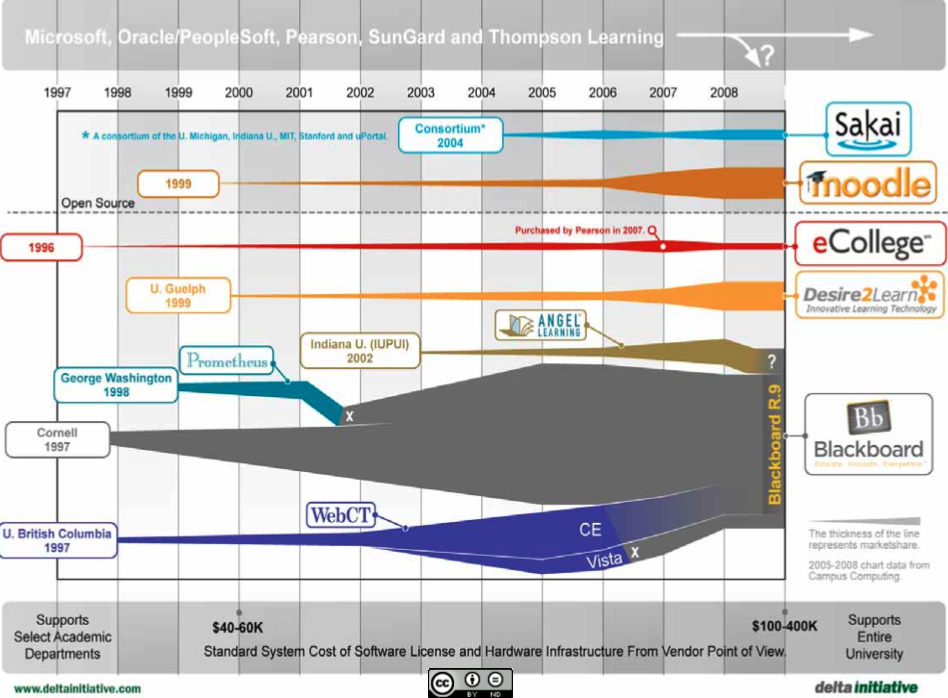
Multinational IT companies (for example Microsoft, Cisco, IBM, SAP and Oracle) provide e-learning solutions of various complexities. There are also specialized providers of e-learning solutions. These specialized providers can be either multinational suppliers or national suppliers. The national suppliers tend to exploit local differences in the learning landscape. Most of these private suppliers of solutions tend to be closed, in the sense that the solution is designed to fit the complete needs of an organization.
There are also new entrants to the market coming from the open source community. These solutions tend to come from publicly funded projects, or from academic research activity.
There is an obvious and large difference between the design of Open source solutions and proprietary solutions. The open source solutions tend to be developed by a network or community of developer across the web. Proprietary solutions tend to be developed by a single laboratory, looking after the needs of the owners.
Whatever technology is implemented by an organization, there are always costs to be paid. These costs include licenses, installation and maintenance, and the payroll costs of all of the people working on the platform.
Today, the level of professionalism exhibited by both open source and proprietary solutions are comparable. There are a multitude of suppliers of e-learning tools, platforms, and services. The magazine e-Learning Age lists 27 suppliers of LCMS and 150 suppliers of LMS solutions at www.elearningage.co.uk/suppliers.aspx (accessed 1/4/2010). The Tenegen Community has worked with the following systems.
Sulinet Digital Learning Base (http://sdt.sulinet.hu/)
The Hungarian organization, Sulinet, won a Comenius-Edumedia-Award in 2007. This is awarded by the Society for Pedagogy and Information (GPI), a scientific society for multimedia, educational technology and media didactics, for outstanding products in the field of ICT-supported educational media. www.sulinet.hu/tart/cikk/Rca/0/31710/1. The honor was received in Berlin by the representatives the Hungarian Education Community Service Public Company and Sulinet Program Office.
The SDT Digital Learning Database is a repository of digital learning materials. In the SDT teachers and students of general secondary and vocational schools find many thousands of digital learning materials, and teachers are invited to collaborate, and to extend the database with their own digital educational products.
Moodle (https://moodle.org/)
Moodle was initially designed and distributed by Martin Dougiamas in 1999. Dougiamas is an Australian developer and scientific researcher. It is released as an open source-code system providing learning and content management. The aim of Moodle was to develop a new system which, contrary to first generation framework systems, supports cooperation between teachers and students. It is very interesting to examine how this application has become so widespread in so short a time. It could be that this is a result of its excellent technical features:
|
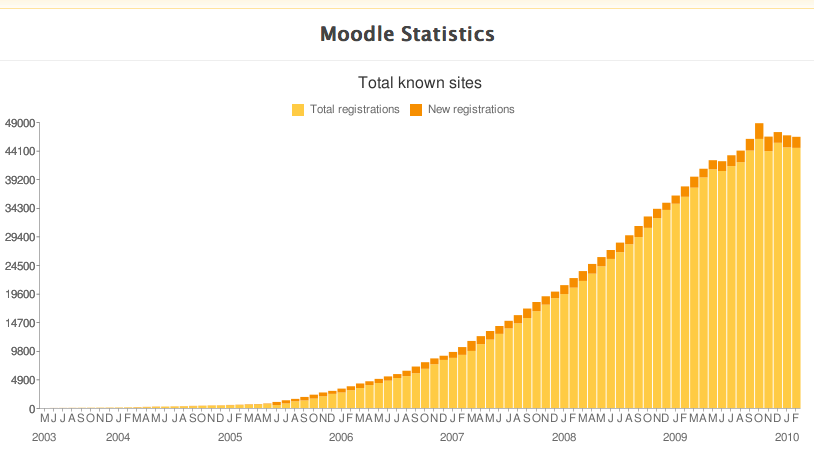 |
More and more institutes have joined the community of Moodle users. The growth in its number of users and sites can be seen by the accompanying figure from moodle.org/stats/ (accessed 1/4/2010).
ILIAS (http://www.ilias.de/docu/goto_docu_root_1.html)
ILIAS is a web based e-learning framework system to support learning materials and it providing both LMS and LCMS service. It is being developed with the coordination of the University of Köln (based on PHP, MySQL). Since September 2000 it has been distributed as open source-code software. It is worth checking it application statistics. The sourceforge (https://sourceforge.net/) statistics are here - www.ohloh.net/p/ilias?ref=WidgetProjectThinBadge. (accessed 01/04/2010). There are 95 logged downloads for ILIAS. Ilias also has statistics at www.ilias.de/docu/goto_docu_lm_470.html (accessed 01/04/2010).
Blackboard (http://uki.blackboard.com/)
The first version of e-learning products was branded Blackboard CourseInfo LLC in 2000. Blackboard went public in June 2004. Blackboard software is used by over 3,700 education institutions in more than 60 countries, and is the selection of choice by system administrators. This is proprietary software, and has significant capital costs associated with it.
 Exercises
Exercises
1. Visit the Wikipedia site of your country and search for "LMS". Try to find the e-learning solution which is most used in your country, and write a short report about you learned, discuss your report on your learning diary.
References
1. The development of Sulinet Digital Learning Base started in 2004 with the support of the Hungarian government. SDT is an e-learning framework system fits for the Hungarian Public Educational System. It can be used free of charge. Currently it contains more than 11 000 (mainly secondary school) general and vocational lessons and lesson supplements. www.sulinet.hu/tart/kat/Se (accessed 01/04/2010).
standards
 Learning Objectives
Learning Objectives
When you have completed this session, you should be able to
- discuss the importance of e-learning standards,
- define concept of “learning object”,
- use Learning Objects (LOs) in your pedagogical practice,
- define and use the concept of “metadata” in e-learning.
Industrial standards are used to determine products used in all parts of our life – from a simple bathroom faucet all the way to complex computer networks. These standards allow us to know how to implement and use products; they also define how they can interoperate. So a bathroom faucet will have to connect to a plumbing system, and a computer workstation will have to connect to a digital data network.
Obviously, the extensive application of digital formats would not be possible without world-wide conventions – standards. Electronic courses are made up from of digitally stored assets such as audio, video, picture and animation data – which should all be held in a standard format.
There are a multitude of possible data structures for such data assets. Designers and developers have to follow international standards and protocols to ensure valid and compliant computerized environments.
Standards in e-learning
One of the general purposes of standardizations is the saving of resource. The same is true in case of e-learning. One of the central issues of e-learning standards is based on the concept of “learning object”.
A learning object is a resource, usually digital and web-based, that can be used and re-used to support learning. (en.wikipedia.org/wiki/Learning_object accessed 01/04/2010.)
There are advantages to dividing digital content into elemental parts (concepts, exercises, illustrations, etc.), to identifying the units unambiguously (as books are in library catalogues) and to storing them in digital databases with their descriptive attributes, such as:
- Enabling browsing or searching at any time,
- Supporting reuse for other lessons, creating customized lessons to meet different needs
- Utilizing the elements in different environments or frameworks.
Learning Objects
|
The concept of “learning object” - developed as a result of methodological researches - has a prominent role in the e-learning terminology. Learning Object (LO) – in terms of methodology and didactics is the basic unit of lessons which cannot be further divided. It can be handled individually and has its individual meaning. Occasionally it can be utilized in more subjects for more topics (and can be resembled mostly as an entry of a digital lexicon). Examples: graphics, pictures, animations, video clips, exams, definitions, concept definitions, exercises, formulas, etc. The development of this concept was encouraged by three basic needs:
|
Learning Object Metadata – LOM
One does not need a lot of experience in the world of digital assets in order to understand that computers cannot search the contents of a picture or digitized voice.
If a digitally stored picture has to be found on the Internet some description of its contents must be given. When you are searching for a painting in a database, you have chance to be successful only if the name of the artist, the title of the painting or the date of painting, etc. are stored together with the digitalized version of the painting. The "title of the painting" and the "name of the artist" are examples of metadata – data about the data.
E-learning solutions use the idea of "learning object metadata". This approach fulfills (or may fulfill) the following requirements:
- Reusability – LOs developed for one situation, together with descriptive metadata, can be stored in one database. Such LOs can be discovered later and reused in another situation. Thus we can reuse LOs for the benefit of new lessons.
- Flexibility – with the help of Los, suitable lessons can be created for a given target group.
- Uniformity – when creating LOs, standards have to be applied in order to be able to organize them in a simple way for many e-learning platforms.
- Simple refreshing – when needed; old, out-dated objects can be simply changed without rewriting the whole lesson.
- Economy –reusability reduces the costs of producing learning content.
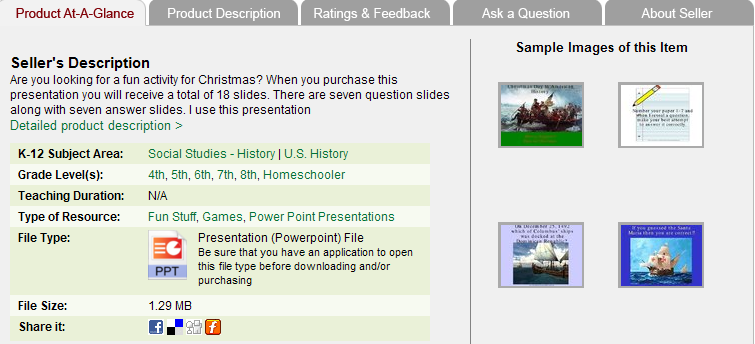
In the picture, above, you see metadata for a learning object published by a teacher in an on-line repository – used in the US as a market place where teachers can share their works with each-other. On this site teachers from all over the world offer their assets, as well as their tools, and even complete lessons. There is opportunity for selecting, evaluating, and downloading digital content free or for money.
Standard Organizations
Aviation Industry CBT Committee (AICC)
 AICC (see on Wikipedia) is an organization for companies applying computer supported educational methods. It was established in 1998. It develops recommendations and standards to the development and mediation of computer based education packages. Standards are not exclusively used in aviation industry but worldwide in other industries too. AICC has become a de jure standard.
AICC (see on Wikipedia) is an organization for companies applying computer supported educational methods. It was established in 1998. It develops recommendations and standards to the development and mediation of computer based education packages. Standards are not exclusively used in aviation industry but worldwide in other industries too. AICC has become a de jure standard.
Instructional Management Systems (IMS)
 The IMS is an Association which supports the development of standards, innovation, best practice and recognition of superior learning impact, in the field of e-learning.
The IMS is an Association which supports the development of standards, innovation, best practice and recognition of superior learning impact, in the field of e-learning.
This standard has been established and maintained by IMS Global Learning Consortium – an international nonprofit organization, whereto anyone can join freely (www.imsglobal.org/aboutims.html). The IMS standard is mostly used on the following areas:
- tests, examinations,
- content management,
- metadata,
- student information,
- company information (learning methodology, access regulation, etc.).
IEEE Learning Technology Standards Committee (LTSC)
The Institute of Electrical and Electronics Engineers is a non-profit alliance with several thousand members being active mainly in different technical fields. Among many other things it is also being the developer major standards of computer network communication. Its professional committee specialized on e-learning systems called IEEE LTSC (Learning Technology Standards Committee - http://www.ieeeltsc.org/about/), with 20 work teams. The committee designated the following areas of e-learning framework systems for standardization:
- General – structure, reference model, concept lexicon
- Student related services ( student identification, student profiles, evaluation of student activities)
- Content related services – storing, compressing, organizing, and maintaining syllabuses.
- Data and metadata – storage structure, systematization, etc.
- Complementary applications –software environments
 Advanced Distributed Learning
Advanced Distributed Learning
The ADL (Advanced Distributed Learning) organization was established by the United States Ministry of Defense and the White House Office of Science and Technology Policy in 1997 (https://www.adlnet.gov/about-adl/).
Sharable Content Object Reference Model - SCORM
![]() According to ADL their target was to provide the highest level of electronic education, that could truly served the custom needs of clients. The SCORM standard was prepared with the aim of being the structural model for web based content, and it tries to unify the results of the IEEE LTSC and IMS standards, concentrating on the criteria of reusability.
According to ADL their target was to provide the highest level of electronic education, that could truly served the custom needs of clients. The SCORM standard was prepared with the aim of being the structural model for web based content, and it tries to unify the results of the IEEE LTSC and IMS standards, concentrating on the criteria of reusability.
The Standards Process
As the eLearning market grows, the quantity of learning materials available online has soared. So too has the number of tools for content creation, content delivery and applications for content management. Common standards for metadata, learning objects, and learning architecture are mandatory to ensure success of the eLearning. Fortunately, the work to create such standards for learning objects and related standards has been going on around the world for the past few years. This includes the creation of accredited standards from the IEEE Learning Technology Standards Committee (LTSC) for Learning Object Metadata, Computer Managed Instruction, Course Sequencing, Learner Profiles and much more.
The process of developing standards includes work form all of the organizations noted above, and can be shown in the diagram below:
All of these standards are built on the W3C XML standard (and hence the ISO SGML standard), which is the building blocks of the web itself. The HTML instance of XML shows the value of using standards, and many organizations believe that simply using XML itself is standard enough, i.e. using standards for content, not just its packaging or description.
 Exercises
Exercises
1. We have a common learning database in Moodle on the Tenegen home page. This icon takes you there: ![]()
Visit this database and check what kind of metadata is used for describing the different learning objects. Select one of your “learning objects” – it may be a digital photo, a test created in Word, an Excel sheet, anything you made as a helping tool for your earlier lessons – and load up this learning object with metadata. How? Look for help in the Help menu: Uploading LO into the Moodle database
2. Visit web page https://www.teacherspayteachers.com/. On this site teachers offer their educational tools and content from all over the world. There is an opportunity for selecting and evaluating downloaded digital contents free or for money. Take a look at their metadata and take a look at some lessons! You may also have some assets in your own databases? Why don’t you offer them for consideration? Write a few words about it in your learning diary.
References
1. IEEE P1484.1/D7, 2001-03-11; Draft Standard for Learning Technology — Learning Technology Systems Architecture (LTSA)
competences
 Learning Objectives
Learning Objectives
When you have completed this session, you should be able to
• discuss the competences defined in Bloom-taxonomy and related to e-learning
• interpret the concept of e-learning competences related to my pedagogical practice
This flower was drawn by two Canadian researchers (B. Holmes, J. Gardner, 2006. [1]). In this, they collect the competences which are needed to take advantage of the options for learning provided by the worldwide web. This is one model of competences – there are competing models. 
According to Holmes and Gardener, it will become difficult to imagine learning without cooperation on the net.
Key issues are:
• Searching within online information,
• selecting the elements effectively for our needs among the huge amount of information saved on the WWW
• becoming productive members of some communities organized on the Internet and
• helping others to learn.
"e-Learning requires different types of engagement, categorized in the framework of key practices or skills illustrated in the petals of the 'e-learning flower'."
The "e-learning petals" recall Bloom’s taxonomy [2], but while the different competences have hierarchic structure in Bloom, the Canadian authors say activities related to e-learning are often done simultaneously or parallel and so competences develop, or can be developed, in parallel with each other.
Note: the radial nature of the ‘flower petals’ imply that there is no hierarchy within this framework. In any one instance, the practical activity undertaken by the learner may involve only one or perhaps several of the actions or skills denoted in the figure. While it might be possible to suggest levels of complexity to associate with the elements of this framework, it is likely that such a consideration will be irrelevant. It will be the actual context and the learner's needs and aspirations that will determine which practice or skill is appropriate.
The competences identified are:
• search & select - identifying the sources where the information can be found and then selecting the most relevant.
• explore - discovering information while browsing without any concrete aim that might match our interest or meet our needs.
• test - the online information might be published in special forms, such as simulations and games, giving an opportunity to the learner to try out the different cases. This interactive engagement offers them the possibility to interact, to change the conditions related to their study.
• analyze and synthesize - the learner should be able to analyze the different suggestions offered to solve certain problems, and than they should synthesize them to give an answer to specific questions.
• collaborate and discuss - the networking platform offers new ways for collaboration. The new generation - sitting in the today's classrooms - is always ‘connected’. The potential of articulating ideas with others through the internet connections, and gathering reflections from others, has considerably increased learning options in recent years.
• understand and apply - based on collected information – through reading lessons, discussion, analysis and synthesis – the learner reaches a higher level in solving problems; he or she develops deeper understanding and an ability to apply this new skill in making decisions
• create and promote - e-learning offers new opportunities for learners; they can easily create their own content and share knowledge, through networks, in the form of digital learning objects. Using mechanisms for accessing, storing and retrieving the information they can benefit from the experiences and knowledge of others, hence fundamentally changing the learning process. Technical innovations can make it easier for the teachers to author and publish digital content, and to invite and to promote students to take part in collective creative work.
Similar ideas were developed in Hungary in 1997 (Bessenyei, 1997), although not with respect to learner competence analysis but with respect to the analysis of teacher competences. Dilemmas raised about the development of e-learning are enhanced given that more than a decade has passed since this article was published, and the questions raised then are still current.
"The widespread application of new information processing tools raises many different issues relating directly to teachers’ education. Students majoring in pedagogy will work in an environment where they must give answers to many practical problems."
• How to process, maintain data?
• How to work with search engines?
• How to use computers’ processing capacity for statistics?
• What sort of education programs can be found on the net, and how are they found?
• How can a syllabus be created from information on the worldwide web?
• What conversation techniques can involve children’s life experiences?
• How can cooperative learning be organized between network systems?
• How can interactive contacts be maintained with other schools, parents, local and central education management and what are the opportunities of network connections when being involved in local decision making processes? How can the potential that the students have more experience in the digital world than many of the teachers be utilized? How can their experience be utilized in terms of pedagogy? " [3]
 Excercises
Excercises
1. Is this proposition timely? Are the competences detailed on the petals really important for your student to be successful in learning? Can you identify examples from your pedagogical practice aimed at improving the listed competences of your students? Write your thoughts about this in your blog.
2. Are the questions - asked by Istvan Bessenyei - timely? Should teachers be able to answer these questions while educating the members of the next generation? Please share your opinion with us writing it into your blog.
References
[1] Bryan Holmes, John Gardner: E-learning concepts and practice, SAGE publications, 2006
[2] According to Bloom-taxonomy (Bloom, 1956) from realization through more complex levels of knowledge we get to the uppermost level, the evaluating level. According to the model, the hierarchic levels are:
• knowledge (repeating, definition, organization)
• comprehension (description, explanation, definition, realization, selection, translation)
• application (application, practice, presentation, illustration)
• analyzing (classification, comparison)
• synthesis (construction, production, planning, handling, organization, recommendation )
• evaluation (decision, support, value definition, evaluation, description)
See details of Bloom - taxonomy here: http://course.tenegen.eu/pluginfile.php/1566/mod_data/content/1951/Bloom_taxonomy.doc
[3] István Bessenyei: Világháló és leépítés, Educatio, 1997 winter issue.
Net Generation
 Learning Objectives
Learning Objectives
When you have completed this session, you should be able to
- to understand why there is such intensive research into understanding the phenomena of the "Net Generation",
- to discover the networking attitudes of students,
- to participate actively in an online discussion based on a web conference system.
The answer, according to the survey, a definite "yes". It concluded that the age-group between 16-25 -- born into the information era between 1982-1991 -- have different learning behaviours to earlier generations.
This section will summarise the conclusions of the survey, and highlight the main characteristics of the Net Generation as formulated by the authors.
Generational features
The Net Generation are:
-
fascinated by new technology: they are intuitively using the IT devices and navigate on the Internet, due to the fact that they spend many hours every day playing video games and being connected to the Internet.
- not bothered too much about the way technological gadgets work and mostly not even interested in that.
- reluctant to read a large amounts of texts, they are more visually literate than earlier generations.
- commonly using more than one medium at a time: they watch TV, talk on mobile phones, listen to music or the radio simultaneously - they are familiar with "multitasking".
- fast at information consumption: they are used to receiving information very quickly, and they expect immediate responses.
using technology intensively in their socialization: they are willing to join physical, virtual and hybrid communities as well.
How do they learn?
The Net Generation:
- do not think linearly: "Let's build something from what we have and something will come of it".
- are results oriented in learning -- and impatient: they show unwillingness to work if the parameters of the 'why' and 'how much' are not clear; they start only when the exact rules, procedures, and schedules are clearly defined.
- prefer "learning by doing" rather by being told what to do. "The role having grown up with video games plays in this preference is unclear, but they learn well through discovery—by exploring for themselves or with their peers." [1]
Informal students of the Internet
What do they say about the net? Some student quotes [1]:
- "I can find lots of new things, and I can learn easily".
- "I can search for anything".
- "I am constantly connected and I can "discuss" problems with others".
They are aware of the fact that not every piece of information from the Internet is true. By communicating with each other they respect each others' opinion, often much more than that of their parents, e.g. if they have a health problem, they are more likely to ask about it in their net community rather than of their parents.
What they think about teachers and school?
More quotes:
- "Technology is important but it can never replace teachers".
- "Teachers should be prepared and should be good lecturers (!)".
- "There is no motivation without teachers".
- "Schools are very important because of the community they provide"!
A study by Ságvári Bence (Managing Director of the Hungarian research institute ITHAKA), entitled "Fanta Trend Report", was published in 2009 and discussed the networking attitudes of Hungarian youths. According to this study, based on data gathered from youths in the age group 16-24, they spend a major part of their daily net time searching for new information, news and even learning. However, he said most teachers believe children use the net mostly for playing games. In the magazine "Business Hungary" (November, 2008.) there is an article entitled "Digital Generation" [2] referring to this publication by Ságvári, in which the author sums up the results of other findings related to questions about Net Generation:
"For many adolescents, digital experiences on the Internet have become a substitute for real experiences, says Ságvári, and in a way, digital life has become real life. As they are constantly bombarded with information, the border between culture and commercials becomes blurred. He wonders what the end result will be: 'It remains to be seen whether it will lead to a generation that has lost its touch with real life, or whether on the contrary, these kids become super-communicators who are constantly in touch with the world at large.'"
 Exercises
Exercises
1. Search publications in your own country dealing with the question of the Net Generation. Collect some links about this field, publish them in your learning diary and share them along with your comments!![]() 2. Look at other students in your classroom. Do they behave like members of the Net Generation? Make your comments on the Agora forum.
2. Look at other students in your classroom. Do they behave like members of the Net Generation? Make your comments on the Agora forum.
References
[1] Educating the Net Generation, Diana G. Oblinger and James L. Oblinger, Editors, 2005 EDUCAUSE. http://www.educause.edu/research-and-publications/books/educating-net-generation
[2] R. Hellinga: Digital generation, Business Hungary, November 2008., page 12.
- creating new contacts easily and quickly (often hiding their identity): the Net increases openness to contacts.
- always connected: they feel uncomfortable when their communications devices (e.g. pda, laptop with internet connection, mobile phone, etc.) fail to keep in contact with others.
Digital natives and immigrants
 Learning Objectives
Learning Objectives
- To discover the networking attitudes of students.
- To understand the terms "digital natives" and "digital immigrants".
- To be able to take part in an on-line discussion based on a web conference system.
 Reading
Reading
 Digital natives and digital immigrants
Digital natives and digital immigrants
"THEY are variously known as the Net Generation, Millennials, Generation Y or Digital Natives. But whatever you call this group of young people—roughly, those born between 1980 and 2000—there is a widespread consensus among educators, marketers and policymakers that digital technologies have given rise to a new generation of students, consumers, and citizens who see the world in a different way. Growing up with the internet, it is argued, has transformed their approach to education, work and politics." (Economist online, England, issue on March of 2010)
The theory of ‘generations’ - shown on the table below - was developed in the early 1990s byAmerican sociologists Neil Howe and William Strauss. Each generation has its own ‘character’ – a character shaped by their most relevant economic, social and cultural activities and attitudes.
Who are the digital natives?
The most widely used name for the new generation was initiated by the American writer Marc Prensky:
"What should we call these 'new' students of today? Some refer to them as the N-[for Net]-gen or D-[for digital]-gen. But the most useful designation I have found for them is Digital Natives. Our students today are all 'native speakers' of the digital language of computers, video games and the Internet." (3)
| Created by Michael Wesch in collaboration with 200 students at Kansas State University. | Marc Prensky: Twenty-first century learning, teaching and technology |
... and the digital immigrants?
"Those of us who were not born into the digital world but have, at some later point in our lives, become fascinated by and adopted many or most aspects of the new technology are, and always will be compared to them, Digital Immigrants" (Prensky, 2001).
Nowadays there are thousands of studies about the Net Generation, digital natives and immigrants, and there are many different opinions found in these the studies. The English online magazine - the Economist - published an article in March of 2010, and invited readers comment on it. Among the people who commented was Don Tapscott, who was one of the firsts educational researchers to draw attention to the Net Generation.
"This is an actual generation and they have different brains because how you spend your time during adolescence is the main determinant of brain development. They are a powerful force to change every institution in society. This research is summarized in my 2009 best seller Grown Up Digital: How the Net Generation is Changing Your World."
Not all comments agreed with Don. Comments from the opposing view included:
"The only noticeable differences of this so called digital generation are: they think tha plagiarism is a right, cut-and-paste is writing, uncritical thinking is cool, attention deficit is a virtue, incoherent thought is also cool, being smart is dumb, swearing often is natural, being polite is stupid, form over substance is IT. What a great generation for humanity!"
"The Digital Native myth is quite damaging to teacher professional development, I think, because it tells somewhat confidence-deprived teachers that in their middle years that they can never catch up with their young super-whiz students. In fact, from my experience, the qualities that are most needed in teachers using the new technologies are not so much to do with computer skills but thinking skills and mental flexibility. For example, skills to judge whether a Wikipedia article is credible."
 Exercises
Exercises
![]() You are asked in assignment TC01A03T to describe the learning and networking attitudes of your students. You should carry out a survey of your students to determine this, and then share your conclusions with other participants of the course. Finally you will be asked to formulate conclusions agreed by your group, based on individual results. The assignment TC01A03GR should be submitted as part of your teamwork.
You are asked in assignment TC01A03T to describe the learning and networking attitudes of your students. You should carry out a survey of your students to determine this, and then share your conclusions with other participants of the course. Finally you will be asked to formulate conclusions agreed by your group, based on individual results. The assignment TC01A03GR should be submitted as part of your teamwork.
For your own work: a) You are free to use the online "Questionnare for students" published on the front page of Tenegen: your students can access this survey without registering on the portal. b) You can edit your own questionnaire; or c) You are free to setup your own survey based on interviews with your students.
References
[1] The net generation, unplugged, The Economist, March 4. of 2010.
[2] Marc Prensky is the author of Digital Game-Based Learning (McGraw-Hill 2001) and Founder and CEO of Games2Train. His website: http://www.marcprensky.com
[3] Marc Prensky: Digital natives and digital immigrants (2001)
case study
Survey: 3rd Grade Secondary School Students (2008)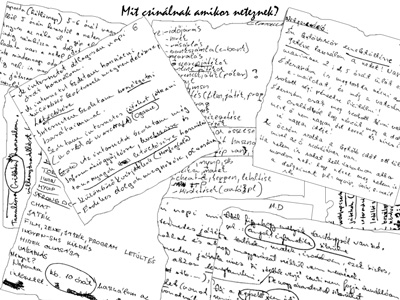
In 2008 an earlier project looked for answers to the following questions, through participants on a course similar to the Tenegen course:
- Is there really a 'net generation' sitting in our classrooms?
- What do we know of their learning and Internet use habits?
- Is it important for teaching that we get to know these habits?
- If we do get to know, can we use make effective use of this in our pedagogical work?
One of the participants a Hungarian IT teacher conducted a survey in his class using the following questions:
- What do you use Internet for, and how much time do you spend for using the net?
- Would you like to use on-line lessons, and which subjects could be best adapted for on-line study?
- In your opinion, are teachers at your school able to develop such on-line course?
Though this was a very informal survey, with children simply writing their answers on slips of paper, there was nevertheless the distinct view that many children become "informal students" through their use of the Internet.
Is there a Net Generation sitting in my classroom?"I was curious to find out what the students of my school think about the 'net generation'. I teach information technology in two 3rd grade classes (this year they learn programming) so I asked the kids in my own class (30 pers) to volunteer their views. Only five families among the 30 children doesn't have Internet access,. The survey cannot be interpreted a representative one, however I got the following result based on the answers given to my questions."
|
Multimedia
Learning Objectives
When you have completed this session, you should be able to- meaningfully define multimedia systems,
- identify different stages of a multimedia system.
 Reading
Reading
|
Media is the plural form of the Latin noun medium originally meaning a person able to mediate between people and the spiritual world. |
Methods of digitizing text are as old as PCs but analog-digital conversion has not been easy, even since the wide-spread use of personal computers.
The technological novelty of the first Multimedia PCs (at the beginning of the 1990s) was their ability to display analog films onto a monitor operating under the control of digital technology. Ever since, we define a computer system as a multimedia system when it is able to integrate at least one discreet (time-independent) and one continuous (time-dependent) medium.
The widespread use of multimedia dates back to the beginning of the 1990s when the capacity and speed of personal computers supported the storing, transmission and playing of memory hungry media elements (pictures, audio materials, videos). 1992 was an important year in the history of multimedia, as the introduction of the World Wide Web made the use of multimedia elements a near necessity.
of multimedia, as the introduction of the World Wide Web made the use of multimedia elements a near necessity.
The development of communication tools based on computer technology, - technological convergence – has significantly speeded up the spread of multimedia, and the areas of application are becoming ever broader. Multimedia provides interactive information in museums, satellite positioning and navigation systems (GPS), surveillance camera systems in streets, and digital televisions – which will replace traditional televisions within a few years – which can be regarded as a multimedia. The next generation will see us borrow books from a multimedia “world library”, and watchingdigital TV -- though the actual appliance will not necessarily be a TV as we know it.
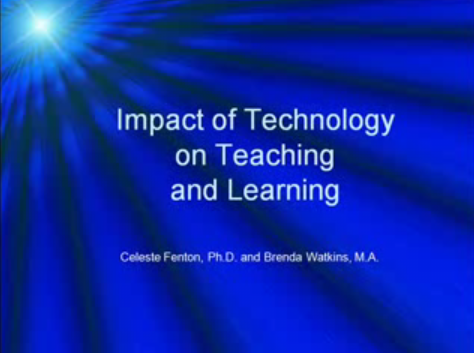
 Excercises
Excercises
"Advances in technology have powered paradigm shifts in education (Frick, 1991)...the video from the award winning authors of Fluency in Distance Learning (www.tdsolutionsonline.com) encourage educators to use technology in new ways to support and transform erstwhile ways of teaching and learning." (YouTube)
Do you agree with the author?
Watch this video, and write your opinion about its message in your learning diary!
in education
 Learning objective
Learning objective
When you have completed this session, you should be able to
- define term "multichannel mediation",
- list the work phases in multimedia development,
- list the competences needed for multimedia development,
- estimate the costs associated with educational multimedia,
- identify your own potential role in educational multimedia development.
 Reading
Reading
One of the key quoted features of multimedia is that it: conveys a message through several channels at a time using information aimed at several sense organs (though listening and seeing, for example) simultaneously.
Research has shown that if we use several organs of perception at the same time, we are able to process more “data” per unit time so the intensity of learning through multimedia can improve. On average men are able to remember 20% of information heard, 30% of information seen and 50% of information simultaneously heard and seen, but the best result (80%) can be achieved if we see, hear and need to “act” during a lesson.
Educational multimedia - multimedia software - offers instructional designers a range of opportunities to involve the learner intensively with the learning process , including the potential of choosing a personal learning path. It is individual vision and ability that limits the range of possible integrated interactions , including quizzes, problem solving activities, special simulations and animations, etc. All should, however, also require action of the part of the learners. The terms 'interactivity' originated from computer technology, refering to human-computer communication through the specific user interfaces and interactions with software systems. The terms has a special, extended meaning related to educational multimedia because interactivity - shifting the learner's role from observer to participant - is a dominant factor in the improvement of the effectivness of the learning process.

What is the problem with the multimedia?
In a Hungarian comparative study (Nádasi, 2002) the efficiency of different media in learning produced results worth noting:- Neither the 'traditional' or electronic media was proven to be significantly better than the other in terms of efficiency of learning/teaching.
- Each medium carries a specific (additional) opportunity, but it can be exploited only in a well-determined learning environment -- one appropriate to the given medium.
- The efficiency of learning depends to a great extent on how much the teaching material is in harmony with the specific features of the delivery medium.
- Not all teaching materials can be presented effectively through every medium.
- When selecting the delivery medium, and from an efficiency viewpoint, it is essential to consider the learner’s age, abilities and cognitive level , as well as the way a teacher uses the given tools.
- A perfectly elaborated medium, which has already proven to be effective, can be used badly.
According to a national survey (K. Radnóti, 2006), only 54% of Hungarian teachers think that it is worth integrating multimedia into lessons; 21% think it may be useful at times, and 20% of teachers said there was no justification at all to use multimedia in education.
Why is this? Are there specific problems with educational multimedia?
Pro
"Multimedia will provoke radical changes in the teaching during the coming decides, particularly as smart students discover they can go beyond the limits of traditional teaching methods. Indeed, in some instances teachers may become more like guides and mentors along the learning path, not the primary providers of information and understanding - the students, not teachers, become the core of teaching and learning process.This is a sensitive, highly-politicized subject among educators, so educationla software is often positioned as "enriching" the learning process, not as a potential substitute for traditional teacher-based methods." (Tay Vaughan, 1994)
Contra
“After an initial period of enthusiasm, often described as ‘hype’, there are growing doubts about the real demand for educational e-content, and about its relevance for improving learning” (European Commission, 2002). "Learning is based on motivation, and without teachers that motivation would cease to exist. (Educating the Net Generation, 2005) “Despite the considerable efforts undertaken, the eLearning sector is still fragmented and there are many open questions on how to exploit the potential of ICT in education and training. A broad partnership between the various stakeholders of industry, education and training, public sector and civil society is needed for Europe to reap the full benefits of ICT and learning in the knowledge society.” (A review of studies of ICT impact on schools in Europe, European Schoolnet, 2006)
Pro
“Open-endedness and flexible combinations of text, graphics, video and audio therefore are the key stepping stones to enabling e-Learning design to become easier. Designers need to be the creators envisioned by Weizenbaum in the early 1980s, exploring with curiosity and supported by multidimensional ways of working with information.” (B. Holmes and J. Gardner)
Contra
"Obviously it is easier for a student to understand the conformation of ciklohexane in the chemistry lesson if it is presented in 3D format. However, by doing this we might as well remove one small “brick” from the student’s development instead of “building” and promoting understanding. Instead of trying to imagine and understand the position of the binding angles in space, the student sits and waits for feeding his brain with an easily understandable pulp. If the student’s space perception does not develop and the ability to imagine the position of atoms in space regresses, his chances are considerably reduced to be able to imagine the structure of a crystal lattice (just to take another example from chemistry in order to draw your attention to the problem). Naturally students can survive by using several mass-produced mental “crutches” and artificial legs until the end of their high school studies, but this way of learning and teaching cannot be considered normal…” (G. Hanczár, 2007)
Pedagogical and psychological approaches are given special emphasis in the development of educational multimedia. Multimedia software should also pay particular attention to ergonomic requirements. It is relatively simple to determine whether particular material deserves to be classified as “educational multimedia”: if it does not utilize opportunities offered by modern technology in order to promote understanding, materials are merely an example of simple demonstration tools. This poses the question: how difficult is it to meet learning expectations for educational multimedia?
Development of educational multimedia - what does it mean? 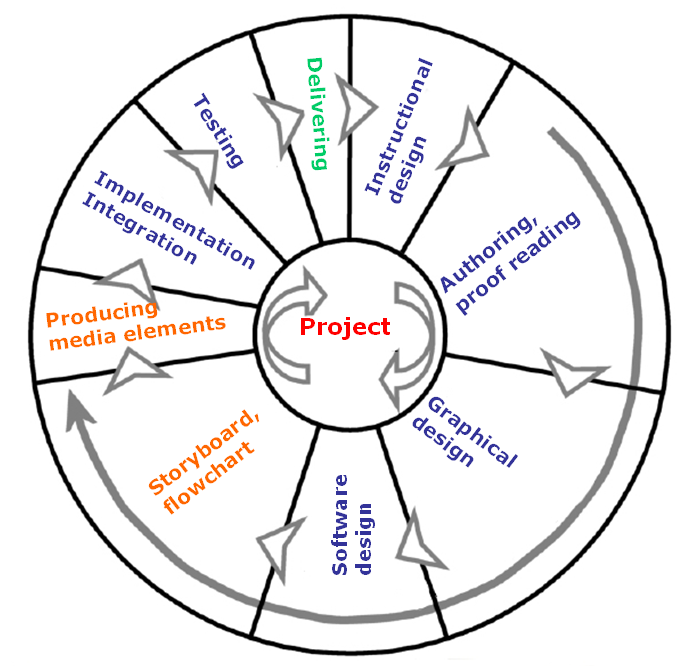
Proper development of multimedia needs the collaboration of several experts within a well-managed project framework. Depending on the pedagogical aims, the project's size and the subject, the project work is generally a team effort that may requirie the participation of instructional designers, content developers, editors, multimedia designers, (graphic artists, animators), interface designers, video producers (camcorders, film editors), musicians, audio engineers and software engineers. So the development may require experience of producing traditional textbooks, but could also require the craft of the motion picture industry and the software industry. The main stages of an average multimedia project are:- planning and costing,
- designing and producing,
- testing,
- delivery.
Similarly to the production of a film, in the design phase creative plans, manuscripts, and storyboards should be prepared. The media elements (pictures, graphics, musics, sound effects, narratives, video clips should be produced, with a high quality. When integrated, the resulting system -- which may be quite complex -- should be an interactive presentation with high visual and semantic consistency.
| "Now computers can be television-like, book-like and 'like themselves'. Today's commercial trends in educational and home markets are to make them as television-like as possible. And the weight of the billions of dollars behind these efforts is likely to be overwhelming. It is sobering to realize that in 1600, 150 years after the invention of the printing press, the top two bestsellers in the British Isles were the Bible and astrology books! Scientific and political ways of thinking were just starting to be invented. The real revolutions take a very long time to appear, because as McLuhan noted, the initial content and values in a new medium are always taken from old media." (Alan Kay, 1996.) |
To answer the question posed at the start, some of the problems can be explained by the fact that in early dvelopments the concept of 'multimedia' was not thoroughly elaborated, particularly as the complexity of the theme was greater than first thought. There is no doubt that educational multimedia -- with attractive, visually consistent animation, simulation games, with pedagogically validated interactivity -- will play an important role among the toolkits that teachers will use in this information era, but there is a need to be aware of some facts:
- development is very expensive,
- that low quality multimedia can do more harm than good,
- not all teaching subjects are suitable for presentation as a multimedia.
In this 'e-learning 2.0' period we are over the missconception that only educational multimedia can provide relevant pedagogical tools that meet the expectations of the information society, and hence that we should develop all learning content in the form of multimedia animation and simulations.
While web 2.0 tools for networked learning and online collaborations are coming to the fore, multimedia remains important, but not as the 'king' of the e-learning space, but as one of the educational tools which can be applied in relevant situations by teachers.
| "This new kind of "dynamic media" is possible to make today, but very hard and expensive. Yet it is the kind of investment that a whole country should be able to understand and make. I still don't think it is a real substitute for growing up in a culture that loves learning and thinking. But in such a culture, such new media would allow everyone to go much deeper, in more directions, and experience more ways to think about the world than is possible with the best books today. Without such a culture, such media are likely to be absolutely necessary to stave off the fast-approaching next Dark Ages." (Alan Kay, 1996.) |
The role of teachers in development
As we have seen the roles within multimedia development generally involve professionals from the motion picture industry, from the software industries , and from other creative areas. Multimedia development is not a personal venture (albeit Leonardo da Vinci was scientist, architect, creative designer and poet folded into one!).
However educational multimedia cannot be sucessful without the experience of teachers. Teachers should be present in the developments, as instructional designer, author, pedagogical or methodological experts.
In e-learning 2.0 the focus hass moved to applications for sharing small electronic educational resources - learning objects - prepared for special pedagogical aims. Learning Objects can be published and shared through the social networks, and among the self organized online social communities of teachers. Web 2.0 tools offer a very different paradigm to that of the large multimedia systems with their complicated publication development paths. Now teachers can construct valuable repositories, storing a large numbers of small educational elements and offering opportunities for teachers students an outlet for their creativity.
 Exercises
Exercises
1. Please record your opinion, in your learning diary, about educational multimedia you have already used in your pedagogical work!
For this course we have established social bookmarks for sharing links related to the topics discussed in the lessons. The website of the bookmarks: http://www.diigo.com/user/tenegen. Please extend the lists with links to online educational multimedia you think is worth sharing with us. (To enter a new bookmark you need to login with the account details of user: tenegen, pasword: netgen555.)
2. Do you have creative students who are experienced in creating digital pictures, editing videos and digital sounds? If yes, would you (could you) involve him or her in your development? What do you think about the future: could members of the net generation ever take part in the teachers' pedagogical work as creative partners?
References
1. A. Nádasi: Educational technology and tools, ELTE, Budapest, 2002.
2. Werner B. Korte, Tobias Hüsing: Benchmarking Access and Use of ICT in European Schools, Empirica, 2006, http://www.empirica.biz/empirica/publikationen/documents/No08-2006_learnInd.pdf
3. Z. Kerber: Bridges between the subjects National Institute for Public Education, Budapest, 2006, K. Radnóti: What kind of assessment methods are preferred by the teachers in the Hungarian schools?
5. G. Hanczár: What is the problem with the Multimedia? New Pedagogical Journal, 2. issue, Budapest, 2007.
6. Theodore Roszak: The Cult of Information: The Folklore of Computers and the True Art of Thinking,1986.
7. B. Holmes and J. Gardner: e-Learning- Concepts and Practice, SAGE Publications, London, Thousand Oaks, New Delhi, 2006.
8. Alan Kay: Revealing the Elephant: The Use and Misuse of Computers in Education, Educom review, 1996.
9. Educating the Net Generation, edited by Diana G. Oblinger and James L. Oblinger, 2005 EDUCAUSE, http://www.educause.edu/educatingthenetgen
in the communication
 Learning objectives
Learning objectives
When you have completed this session, you should be able to
- differentiate between the concepts of hypertext, hypermedia and multimedia,
- understand the historical significance of changes in human communication.
 Reading
Reading
Hypertext, hypermedia, multimedia
 The three concepts listed in the title are interrelated; trying to define one of them will inevitably lead to the second or the third one.
The three concepts listed in the title are interrelated; trying to define one of them will inevitably lead to the second or the third one.
Social scientists rely on written materials, so it is easy to understand their excitment over the features that text on the World Wide Web can have. There is the possibility of following innumerable links which lead in various directions and to many mental adventures, are seemingly infinite expandable and able to be searched, edited, and modified. Ever since the Internet opened up and made available for higher education institutions, many analyses have been published predicting fundamental changes in the history of human communication.
Though first advocated over 60 years ago, the newly exploited concept of hypertext is one of the mainstays of the technology and offers a new paradigm in the organisation of content.
Hypertext is about electronically stored documents interconnected through nodes, or links. Texts built this was can be extended through linking without obvious limit, and can be found, studied and read by following the linkages. When reading a text, it is easy to follow new text 'nodes', offering new branches, by uniquely identifying the next document in the chain. The identifiers used in the nodes are called “hyperlinks” or simply links.
|
„Electronic linking shifts the boundaries between one text and another as well as between the author and the reader and between the teacher and the student. It also has radical effects on our experience of author, text, and work, redefining each. Its effects are so basic, so radical, that it reveals that many of our most cherished, most commonplace, ideas and attitudes toward literature and literary production turn out to be the result of that particular form of information technology and technology of cultural memory that has provided the setting for them. This technology - that of the printed book and its close relations, which include the typed or printed page - engenders certain notions of authorial property, authorial uniqueness, and a physically isolated text that hypertext makes untenable.” (Georg P. Landow, 1991) |
Hypertext does not force the reader to follow a strictly linear route. Any path can be followed by clicking on a link in the text, and it allows for a relatively easy return to the original text itself. In the confines of a single document, we often do this when we read a footnote or follow a reference to the back of the book. We also do similar when we pick up a completely different book referenced by the one we started to read. The only difference is that in the case of real we have to physically find it on the shelves of the library.
Hypermedia is an extension of the concept of hypertext. In addition to text (text documents), different kinds of media elements -- pictures, audio recordings or videos -- can be found in the referenced nodes. Hypermedia started to take off at roughly the same time as the World Wide Web which was also when hardware limits on the forwarding and presentation of media elements eased. Hypermedia is now becoming dominant on the Internet.
|
„Hypermedia is a holistic world and knowledge model, for it intends to include theoretically everything, the “whole”, and everything is inevitably related to everything. Specialization, which used to save the life of civilization, has become life-threatening, because the parts do not communicate with each other and we forget to think about the consequences. The storing capacity and the operation speed of computers allow us to approach the world in a complex, universal way again.” (J. Sugár) |
Did multimedia or hypermedia come first? Hypermedia was certainly postulated before before multimedia; however, multimedia CDs came into existence before real hypermedia. This was soon followed by hypertext on the then largely text-based Internet. Now the use of hypermedia on the World Wide Web -- based on multimedia elements -- is firmly established. Multimedia can be considered to be a set of medium established for conveying a particular message – for instance an electronic syllabus – with finitely many predetermined access routes. It is more definite than hypermedia in that is is the development of established goals, but this fixed definition limits the potential of following unexpected and unanticipated routes.
The history of the hypertext
The names hypertext and hypermedia were first used by Theodor Holmes Nelson -- the American philosopher and sociologist(*) -- in 1963 when he was thinking about designing a universal, computerised word processor. With the prefix “hyper” he intended to emphasize that this is a kind of electronically stored text having fundamentally different structure from the traditional ones.
Meanwhile the English information technologist Tim Berners Lee (today the leader of World Wide Web Consortium) devised a simple plan for a World Wide Web of information, and presented it in 1989 to fellow physicists as CERN, in Geneva. His plans were accepted and as a result of the developments the World Wide Web (WWW) appeared in 1992. In 1993 CERN and MIT established the W3C consortium (Tim Berners Lee became its president) and shortly after the first graphic browser software -- MOSAIC -- was developed.
Ted Nelson did not like the WWW at all. In his criticism he pointed out that URL based identification is a much poorer solution than the one they had designed in XANADU. XANADU could have been able to identify all units, all letters, all picture fragments and the sound scraps of every document stored in the system, or on the 'net'. Perhaps it was this over ambition that held up progress?
Finally...
Marshall McLuhan (1911-1980), a Canadian literature historian categorizes technical mediums into generation. The first generation mediums are simple extensions of biological sense organs. The second generation can be connected to the appearance of alphabetic handwriting, while the third is connected to the printing of books. The foundation of the fourth generation medium is analogue signal transformation. This covers the development of the radio, the telephone and the camera. Finally, with digital technology came the improvement of electronics and the creation of computers, and hence the establishment of fifth generation mediums.
In his books published in 1962 (The Gutenberg Galaxy) he postulated realtively heretical ideas that caused great controversy. He dared to question whether the closest educating medium to human nature was the written text or the printed book.
His other revolutionary statement was that technical mediums have such a great effect on society that they can change the forms or habits of human production, consumption and contact. In this way they are able to fundamentally influence the means of social development. “Medium is the message” that reformulates the world.
McLuhan did not fully back up his opinions, as would be expected from a scientific work. However through his avant-garde ideas he nevertheless generated mass reaction from his contemporaries – both pro and contra. The resulting disputes about his thoughts are not over yet. Prior to his work, no one had dared to criticize the positive aspects of writing and no one was thinking about how book printing had locked mankind into a visual world for centuries (pushing other sense organs in the process of knowledge acquisition into the background.). He also postulated the “typographic man” who was trapped in an artificial system of signs for centuries.
How is this all related to multimedia? Real pedagogy is mostly concerned with necessary and inevitable paradigm change. Education researchers have determined that, at this time in their development, neither multimedia nor e-learning can meet the levels of educational expectations claimed. The last word here goes to the respected scientist, Georg P. Landow. Though he does not give any recipe for the future, he does comfort us with the fact that our ancestors were not any better at transforming education than we are.
"First of all, such transitions take a long time, certainly much longer than early studies of the shift from manuscript to print culture led one to expect. Students of technology and reading practice point to several hundred years of gradual change and accommodation, during which different reading practices, modes of publication, and conceptions of literature obtained. According to Kernan, not until about 1700 did print technology "transform the more advanced countries of Europe from oral into print societies, reordering the entire social world, and restructuring rather than merely modifying letters". How long, then, will it take computing, specifically, computer hypertext to effect similar changes? How long, one wonders, will the change to electronic language take until it becomes culturally pervasive? And what byways, transient cultural accommodations, and the like will intervene and thereby create a more confusing, if culturally more interesting, picture?" (Georg P. Landow, 1992)
 Exercises
Exercises
Practical experience that assess the impact on learning of hypertext and hypermedia are realtively rare. Do any of your students use this technology when preparing their homework? If yes, do you think is useful or not?
Share your opinion with others on the forums.
References
1. J. Sugár: The medium of thinking, 1998 http://artpool.hu/hypermedia/index.html
2. Dr. Vannevar Bush: As We May Think, Atlantic Monthly, July 1945.
3. Marshall McLuhan: The Gutenberg Galaxy. The Making of Typographic Man. University of Toronto Press, 1962.
4. Georg P. Landow, 1991: Analogues to the Gutenberg Revolution,Johns Hopkins University Press 1992. (http://www.cyberartsweb.org/cpace/ht/jhup/contents.html )
Notes
*Ted Nelson's website: http://xanadu.com.au/ted/
**"Selection by association, rather than by indexing, may yet be mechanized. One cannot hope thus to equal the speed and flexibility with which the mind follows an associative trail, but it should be possible to beat the mind decisively in regard to the permanence and clarity of the items resurrected from storage. Consider a future device for individual use, which is a sort of mechanized private file and library. It needs a name, and to coin one at random, ``memex'' will do. A memex is a device in which an individual stores all his books, records, and communications, and which is mechanized so that it may be consulted with exceeding speed and flexibility. It is an enlarged intimate supplement to his memory." (Vannevar Bush: 1945)
evaluation
 Learning Objectives
Learning Objectives
When you have completed this session, you should be able to
- list the criteria for evaluating educational multimedia,
- do an evaluation with respect to your own pedagogical aims.
| A good rule of thumb for curriculum design is to aim at being idea-based, not media-based. Every good teacher has found this out. Media can sometimes support the learning of ideas, but often the best solutions are found by thinking about how the ideas could be taught with no supporting media at all. Using what children know, can do, and are often works best. After some good approaches have been found, then there might be some helpful media ideas as well. (Alan Kay, 1996) |
It is not easy to devise a list of evaluation criteria to judge the quality of educational multimedia, but it is probably true to suggest that even if a particular solution meets all the technical requirements, it is not certain that it will also satisfy our pedagogical aims .
To determine the pedagogical value of educational multimedia may be as difficult as explaining why do we like, or why we do not like, a painting. Some important points for evaluation are listed below, but this list contains only the "necessary" conditions, or requirements, which may not always be sufficient to help decide whether there is a proper application for multimedia or not. These are also minimum requirements, applicable to all educational multimedia.
An evaluation must take into consideration aspects of general educational content, which can actually be satisfied by textbooks or other more traditional materials used for educational aims. Multimedia goes well beyond this set of content, including user software which has to be examined for conformity and generality. THere also has to be attention paid to the overall presentation, i.e. the consistency of media elements within the overall multimedia show.
Pedagogy, didactics, psychology
At a minimum an evaluation of electronic teaching material must consider the following.
- The structure and the actual content must comply with the set aims, it should be able to be adapted to the learner’s individual learning style, and it should allow the learner to plan the overall learning activity independently (including making it possible to skip certain units).
- The material should attract and maintain the learner’s interest, it should be interactive and should utilize the presentation opportunities of the computer without shifting the emphasis from the content to the way of presentation,
- The material should offer opportunities for practice, through examples, should opportunity for self-assessment, it should motivate by rewarding correct answers, and it should analyze and evaluate the learner’s results at certain times
Assessment criteria
- Does the teaching material meet the set of learning objectives?
- Does it fulfil the target group’s expectations?
- Does it maintain the learner’s interest in the material, i.e. is the principle of maintaining attention achieved?
- Is the principle of patient waiting/expectation achieved?
- Is the principle of confirmation achieved?
Ergonomy
The ergonomics of human behaviour, abilities, limits and other human characteristics should be taken into account when designing tools, machines, systems, work tasks, work environments in order to achieve efficient operation, and to provide a safe and convenient way of application. This is true also of multimedia.
It should be simple to use, should ensure easy navigation, and the layout and the use of icons should be logical. The images and colours used should support and not hinder the handling of the material. The proportion of pictures and texts should be well-balanced and font sizes should be selected to make the text easy to read
Assessment criteria
- Image layout, general impression, originality of image design.
- User friendly (adjusted to the age group) work environment.
- The quality and systematic layout of the navigation elements.
- Occurence of errors.
- The simplicity of the instructions to use (how memory consuming is it to learn).
- Incidents of exhaustion, tension, frustration during usage (appropriate setting of action-reaction time, waiting time).
Media elements
Since media elements affect all the previously set requirements, it is practical to highlight the criteria governing their applications. A basic principle is that media elements and sound effects should be used moderately and only when justifiably used in electronic teaching materials.
- The length of the used video clips should be max. 1-1,5 min, and they should really contain extra information
- Animation should be used only in justified cases, and they should not be too fast
- Sound quality should be appropriate, the narrator’s voice and speed of speech should be comfortable, and any text should be clear
Assessment criteria concerning media elements
Texts
• Simplicity
• Legibility
• Clear structure
• Conciseness
• Eye-friendly image
Symbols-logos
• Simplicity, clarity
• Aesthetic apparence
• Relevance to the symbolized object, phenomenon
• How much do they promote to highlight the main points
Audio materials
• Coherent integration (sg. relevant in the right place)
• Quality, integration of narration
• Originality, appropriate application of background music
Images
• Coherent integration (sg. relevant in the right place)
• Colours, colour combinations
• Quality of images
• Optimalization ( size, quality)
• Quality of figures
Videos
• Coherent integration (sg. relevant in the right place)
• Quality of the video clips
• Optimalization ( size, quality)
Animations
• Coherent integration (sg. relevant in the right place)
• Dynamism ( quick, well-balanced, slow)
• Promoting understanding, drawing learner’s attention
• Graphics
Summary
Creating a textbook requires considerable technical expertise to compile comprehensive, high quality material. Using the right amount of high quality illustrations, selecting the right letter types etc. are all important considerations in the process. However, educational multimedia has to harmonize many more elements. In many cases the material may look really attractive, but the content that the information the creator intended to convey is lost, simply because the multimedia elements are not co-ordinated well and the because emphasis is shifted to unimportant information.
 Exercises
Exercises
Choose one of the multimedia elements that you have already used in the classroom, or if you have never used any find one on the Internet appropriate to your subject. Evalute it according the criteria listed above and publish the results in your learning diary.
References
Alan Kay: Revealing the Elephant: The Use and Misuse of Computers in Education, Educom review, 1996. (http://net.educause.edu/apps/er/review/reviewArticles/31422.html)
Web 2.0

The phenomenon web 2.0 brought a new age in Internet history. This expression was first pronounced in 2004 in a conference for web technology as a collective noun for software help editing contents and making connections on the worldwide web. At that time it was only called as web 2.0 tools. However soon it became clear that the rapid propagation of broadband Internet and the change from readable web to re-writable web is so deep in everyday communication and slowly in all segments of social life which can only be approached as a complex phenomenon.
In the background there is the rapid development of hardware - equipments suitable for creating saving and transmitting digital voice and video. Arhitectures with processors capable to play and store 3D animation were produced. Despite of it the significance of web 2.0 is not hidden in technological results but in the change of how people approach things. Real time sharing of information and knowledge became reality and it is not restricted for only a narrow, upper class of the society. We can raise questions, answer, think together in communities organized on the net, using all medium which can be imagined easily - this is web 2.0.
The web 2.0 phenomenon can result changes in the entire education not only in e-learning solutions. The major consumers of options provided (video sharing, file sharing, online communication tools, online games, etc.) are the members of the net generation and most of them are still sitting in desks.They will not ask the oppinion of schools about whether they should connect to a virtual community about any subject they are interested in.
 Collections
Collections
A young lady, Orli Yakuel from Israel, started the international portal GO2WEB20 in 2006 (https://www.facebook.com/go2web20/) as a source for web 2.0 applications. This is more than just a passion! The number of fans is respectable!
 Exercises
Exercises
"In fact, one of the saddest but most common conditions in elementary school computer labs (when they exist in the developing world), is the children are being trained to use Word, Excel and PowerPoint. I consider that criminal, because children should be making things, communicating, exploring, sharing,not running office automation tools." (Nicholas Negroponte, Massachusetts Institute of Technology's Media Lab)
1. Do you agree? Please come to the Agora, to disccuss!
Bookmarking
 Learning Objectives
Learning Objectives
When you have completed this session, you should be able to
- understand and make informed use of the concepts of "folksonomy" and "tagging",
- compare the features of taxonomy and folksonomy,
- use social tagging and bookmarking in practice.
 Reading
Reading
Taxonomy & Folksonomy
A Taxonomy is a hierarchic classification system. We use them everwhere in our lives, for example the Windows operating system stores documents in a hierarchic classification system. The aim of this type of organisation, i.e. of establishing clear storage structures, is to be able to find things as quickly as possible when needed. This applies to many aspects of everyday activity, whether it is merchandise stored on warehouse shelves, or documents, images and other data stored digitally on hard disks.
Web 2.0 developments have brought changes, not only in respect of Internet applications, but also in the methods of organizing common storage systems too. The goal is the same: to be able to find important information as easily and as quickly as possible.
It is common nowadays to see 'word clouds' -- summaries of important information, important speeches, or even interesting web site -- where each word in the 'clouds' is sized according to its frequency of use in the underlying data. The most frequently occuring words are the largest, and each word is generally also an active link, usually to a list of the content which is somehow related to the given word (expression).
|
You see here the tags from the Tenegen portal and to the right the links related to the tags.(http://tenegen.eu) |
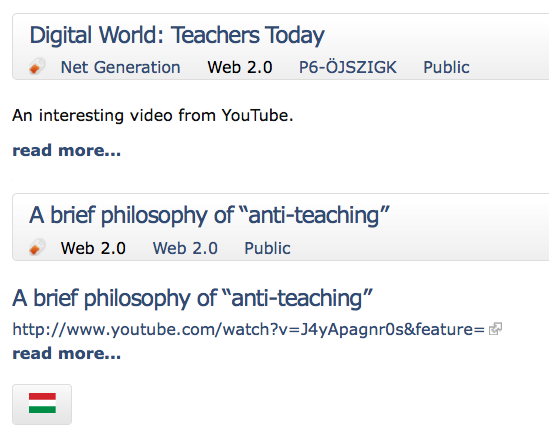 Clicking on the tag "Web 2.0", a list of digital documents ranged in this category appear. |
Web 2.0 applications can offer alternative solutions for organization on-line content. Tags can be added to all images, videos and text, which relate to the underlying content. With 'clouds', for example, searching back into the content is made easy as the font size symbolizes the number of units in a given category. This kind of collaborative method of annotaing and categorizing online content - often created spontaneously - is called a folksonomy, so called as it combines an analogy of the word taxonomy with the phenomena of "social tagging".
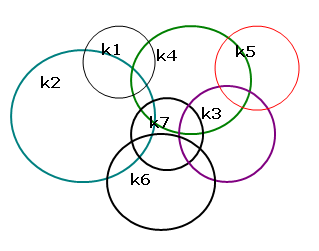 |
|
|
|
The 'folksonomy' side of this diagram shows a user-created cluster of meanings - in which the tags cover each other - whose structure can be illustrated by a Venn-diagram (or in the terminology of relational databases, a "many to the many" relationship). The folksonomy has the potential to account for multiple perspectives, but on the other hand there is the risk that clouds become chaotic. There can be a lot of redundacy if the concepts are not well determined, allowing for repetition. However web solutions employing social tagging methods are popular, offering some proof of its usefulness particularly with respect to making search easier on webpages.
Tagging technics
In applications that use tagging, the tags must be separated with spaces. For this simple reason complex words, and expressions having more than one word, can be difficult to tag. To solve this problem some applications allow the use of underlined gaps (for example using: _) between words (as is the case with delicious). Other approaches use quotation marks around tags with multiple words(e.g. in the link sharing diigo).
One of the most important applications of social tagging is that of social bookmarking, or simply link sharing.
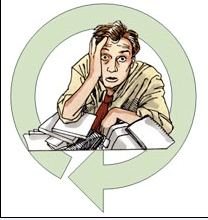 Social bookmarking
Social bookmarking
When searching on the Internet there is always the problem of finding one's way back to page visited earlier. Favorite pages can be organized within browsers, but this is not an ideal solution for two reasons. Hierarchic saving (in folders) is too strict, forcing the use of a specific, embedded categorization. Therefore during search we must often simply reply on one's memory. Secondly, if we intend to share our collection of Favourites with somone, there is no real support in the browsers.
Social bookmarking tools were developed to overcome these problems. Social bookmarks, or link sharing, are software systems, running on servers, and providing help for storing links organised with tags in some way. These systems also support the sharing of these collections with others. The video below shows how social bookmarking can be used.
Basic funcionalities of link sharing tools:
- storing, editing, deleting link descriptors (URL, descriptions, tags),
- e-mailing link descriptions to others,
- sharing links,
- searching back and listing by tags,
- share with RSS service,
- facilitating bookmark editing by built in tools in browsers.
One of the most most popular link sharing applications is Delicious, however the selection is so large that some sort of specialization has appeared. For example, there are link sharing tools that are particularly good for social cooperation (like Newswine), and other that are mainly for scientific use (like Connotea).
Diigo provides a most advanced service. It "knows" what is expected of social bookmarking and presents it in a very elegant way with many extra features. For example, it supports teamwork and is used in a highly integrated fashion. It allow supports the use of quotation marks to separate different tags, and it allows visitors to add their own comments to the entries.
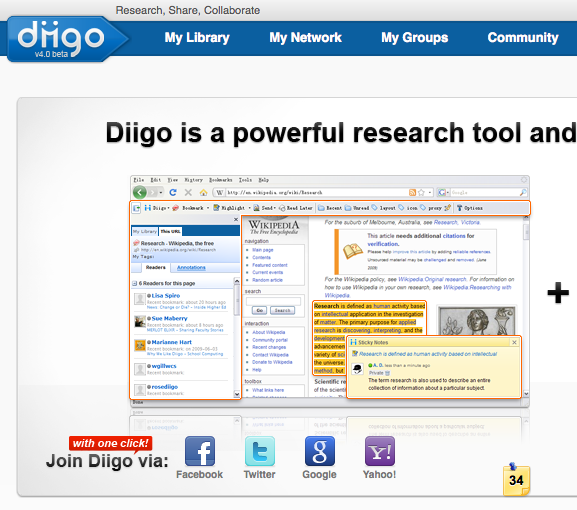 |
|
| On the Diigo website you find detailed tutorial to learn how to use it! | https://www.diigo.com/ user: tenegen, password: netgen555 |
 Exercises
Exercises
- What do you think about the potential for social bookmarking in your pedagogical practice? Would be this method be suitable for your classes in the creation of folksonomy for particular topics? Share your idea by writing these into your learning diary!
Note: Diigo is the best at supporting teamwork! Watch the YouTube video above, and visit this blog to find some useful ideas: http://www.clifmims.com/blog/ ! - Search on the Internet for useful web 2.0 tools, and share the links on Tenegen's Diigo site. (Sign in with the account given above!)
RSS
 Learning Objective
Learning Objective
When you have completed this session, you should:
- understand the significance of RSS in content sharing,
- be able to identify the concepts of news channel, feed reader and feed aggregate,
- be able to apply "widgets" in practice,
- be able to apply RSS for publishing your blog.
 Reading
Reading
The easiest way of following news and new information appearing on the Internet is to visit our favorite pages from time to time and to browse the different subjects.
 |
 |
| Searching for news on web 1.0 | Getting news on web 2.0 |
As the number of interesting pages increases so does the time needed to visit them. Navigating your collection of links becomes more and more difficult, even though browsers provide "Favorites" and "Previous" functions. Visits can be a waste of time if no changes have happened on a given page. Business portals try to keep subscribers up to date by sending out regular newsletters in e-mails (weekly or monthly). This can be a useful way of keeping up with news, but some postboxs can be swamped with the scale of content.
Content "broadcasting" on Web 2.0
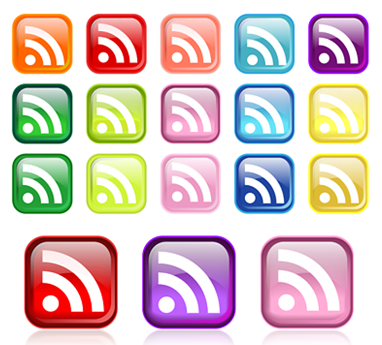 One of the most important features of Web 2.0 is that it has revolutionised - through the technology - how content has become accessible. One area, in particular, is how people are automatically informed about news and newly published contents, but without having to search for this. The first news collecting/news sharing software (around 2004) was only used by big news agencies, like Reuters, but as the amount of content published by the net using public (e.g. blogs) increased rapidly the need and use for these applications grew too.
One of the most important features of Web 2.0 is that it has revolutionised - through the technology - how content has become accessible. One area, in particular, is how people are automatically informed about news and newly published contents, but without having to search for this. The first news collecting/news sharing software (around 2004) was only used by big news agencies, like Reuters, but as the amount of content published by the net using public (e.g. blogs) increased rapidly the need and use for these applications grew too.
News channels
RSS (Really Simple Syndication) is at the heart of these new news channels. It is found on many community pages, such as on YouTube with its news channels, and thematic video collections.
On Youtube, software installed on the portal (on server side) - the RSS feeder - constantly "monitors" and extracts videos loaded up on the particular channel and peridically transmits them to users registered with the news channel. On the user side there is a "client" program - an "aggregate" - which displays the "news" being fed from the server. Users see a brief extract of newest contents, with links, and can decide whether to watch a new video (or read a new text) or not. This technology turns around the way content is accessed. The user does not visit his/her favorite pages -- the most up to date information is fed to him or her.
RSS standards
Standards are vital in ICT, so it is no surprise to find that there are standard developed specifically for RSS technology. The specific service being used will often be marked with the icon for the standard used. The most popular standards are the various versions of RSS, and Atom. Data transmission requires server and client to "speak the same language", i.e. to use the same standard. Look for an icon that marks when RSS service is provided on a web page. Look for this on sites such as newspapers.
How to use RSS
...in browser?
RSS readers are offered in browsers as a standard option. In Internet Explorer this feature is called "News Channel"; in Firefox it is called "Live Bookmark”. If you are searching on a web page where you have found the RSS icon, click on it. On the resulting page, look for the message: 'subscribe to this news'. Following this, and choose Favorites under the "News Channel" tab, and you can choose the extracts of the most up to date news.
...to follow blog posts?
The RSS service is usually built to work with the bloggers in both direction -- news supply and news collection. Visitors can register for news channels of many public blogs, and blog owners can connect to other blogs to display the extracts of latest news.
... with feed readers
There are programs especially developed for reading news -- Google Reader is one of many. These applications allow you can subscribe to your favorite websites in order to get news automatically.
... to create a personal web page?
Another large group of web 2.0 tools provide options for creating personalized web pages. A basic function of web page editors is to collect RSS news, but they also offer other options to create a personalized working platform for amusement - or for learning. Some of these options include:
- calendar, clock,
- links to web pages where there are no RSS services,
- notes, message editors and displayers,
- calculator,
- reading mail box,
- simple games,
- invitation for aquaitances and friends, etc.
These little options for persoanlisation are called widgets.
Netvibes, iGoogle, Protopage, Pageflake, MyYahoo, Microsoft Live are portals, offering "sharing" services suitable for creating personalized, news-collecting web pages. Here are some examples for use by the Tenegen community, partly for experiementation and familiarisation, and partly for potential use in this course.
For a further example, look on the Tenegen's Netvibes site which uses this technology to collect all the blog posts written in students' learning diaries.
 |
 |
| Tenegens page e-mail: tenegen@prompt.hu password: tenegen555 |
See Tenegen's board! e-mail: tenegen@prompt.hu password: tenegen555 |
... to create your message board?
"Bulletin board" (or message board) applications are different from pages using RSS, but they can have features such as "sticky notes" which have a similar bahaviour. The examples shown below illustrate this.
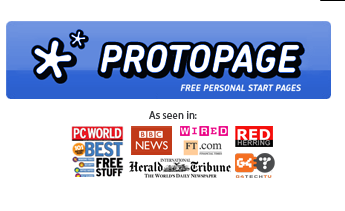 |
There are many differences among the options offered by the various applications. Protopage and Netvibes are feed aggregates (they publish news from websites with RSS feaders built in). Padlet does not quite offer this same feature, but it works in a similar manner to RSS feeders in that you can reach the news posted on its walls from other sites. There is an example of this on Tenegen's protopage. |
| http://www.protopage.com/ | See Tenegen's protopage! user: tenegen pasword:tenegen555 |
Tenegen Teachers - on Netvibes
This site offers a content aggregate of your blog posts. If you write your blog outside of Moodle in a blogger, then you can add an RSS feed on the Netvibes site to your own blog. If all participants do the same, then it is possible to follow the latest posts without having to visit each blog one by one!
Tenegen's Protopage
This web 2.0 tool offers the same functionality as Netvibes, but in Tenegen it is used as a message board for the course. The aim was to evaluate the tool across the Tenegen group to determine whether it is suitable as a pedagogical tool for the project.
To have editing right on these sites (Netvibes or Protopage), login with the account given above. To create your own site, obtain an account by registering through the application!
Tenegen's Padlet
Padlet is a very simple message board system. Compared with the two other solutions discussed above, it has the advantage that anybody can post messages on its 'wall', if the owner so allows. It also has options for content aggregation, but it allows the sharing of news posted on the wall with several other applications like Twitter. It also operates as an RSS feeder.
 Exercises
Exercises
1. Visit the Protopage and Padlet sites and try them out. Create a new message on both sites.
2. If you maintainyour learning diary in Blogger (which has an RSS channel), please add a feed to it on the Tenegen's Netvibes site. To add a feed to your blog, use the following steps:
a) After entering the site, choose an existing tab, and click on "add new content", then "New source".
b) Copy the address of your own blog into the RSS field.
If all students complete this exercise then there is a single place to browse all the extracts of Tenegen blog entries ( ).
).
3. Write a post in your learning diary: have you any ideas about how these tools might help with your daily teaching work?
Concept Map
 Learning Objectives
Learning Objectives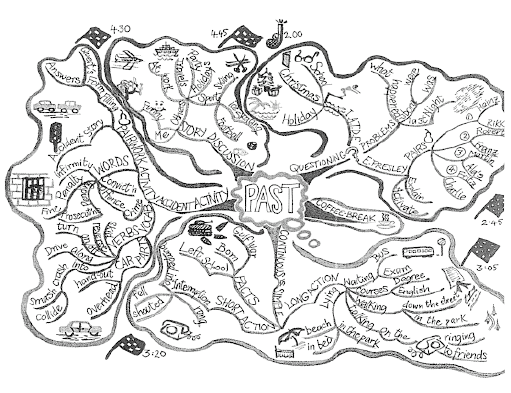
When you have completed this session, you should be able to
- identify mind maps and concept maps as tools of visualization,
- list the basic principles of map design,
- apply Web 2.0 tools for designing mind maps,
- identify and apply Web 2.0 visualization tools in practice,
- discover the possibilities of using mind maps in pedagogy.
 Reading
Reading
Concept Maps & Mind Maps
Have you thought of something and drew a picture while doing so? Visualization can help you get closer to a solution to an issue or problem. Pictures and figures can help with orientation. The expression "a picture is worth a thousand words" is undoubtedly true at times!
Technical developments and project management cannot be imagined without drawings and figures. Programmers and engineers model different steps in any development with flowcharts; Project managers use Gantt-diagrams for timing.
The visual method of drawing mind maps is relatively a new concept, but it can have a very wide application -- perhaps more so that in those areas mentioned above. It can also be useful for problem solving, clarifying concepts or ideas, and understanding phenomena or procedures.
This technology was developed in 1960 by Joseph D. Novák, Professor at Cornell University. He was looking for a problem solving method to help with adding or connecting new knowledge to existing knowledge patterns. He started from the concept that understanding new notions is much easier if connections are discovered between the existing and new knowledge.
"Comprehensive learning can embed new concepts into existing cognitive structures."
Widespread use of mind mapping in the 70s was attributed to the English psychologist and education consultant, Tony Buzan. His book, published in 2002, started an innovative avalanche in the field of mind map software. The handmade mind map (above), which was created by teachers in an English language school, is taken from his book (click for a more detailed version). It is possible that the 'net generation' could make spectacular, creative mind maps with Web 2.0 tools.
Drawing made simple!
Draw small junctions - small circles for instance - on a piece of paper and connect them with lines. Give names to the junctions and replace the circles with simple images. To the end of connecting lines - one or the other or both - draw arrows. You will end up with a construction similar to this:

Each junction can be the start point for one or more connecting lines, which can lead to other, new junctions -- until a tree or a net is created.
 |
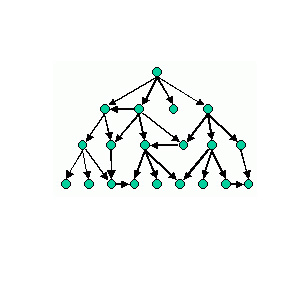 |
| Hierarchic structure | Network structure |
These schematic figures cannot represent the creativity of figures that can be created from these simple elements. It is not easy to show the complexity of human thinking in a linear way. Concepts and keywords describing the subject can occupy the nodes. Lines represent connections between them.
Both stuctures -- hierarchy and network -- are known and have been used in mathematics and software development for many years (mainly in the theory of data storing technology and databases). There is a separate branch of mathematics, called graph-theory, dedicated to network structures.
What are the applications of Maps?
Brainstorming
We are all familiar with Brainstorming. This starts out with a seemingly good idea, but one that lacks clarity and direction. Participants take the idea and build on it, expand it and define it.
Designing sophisticated systems: analyzing complex problems
Mind Maps can be useful for private application and for teamwork, but also where new and complex systems have to be introduced in an institution when it is difficult to see the detail in different segments of the task. Design can develop by drafting the most important elements of a large plan, and gradually adding detail by ever depening analysis.
Drawing Maps can help to uncover badly defined points, can provide a framework for clarifying what is understood, and for highlighting what has yet to be clarified.
Concept systems: illustrating taxonomies
Visualizing taxonomies can be useful in understanding, or making understood, the conceptual structure of a given topic and for showing connections between concepts.
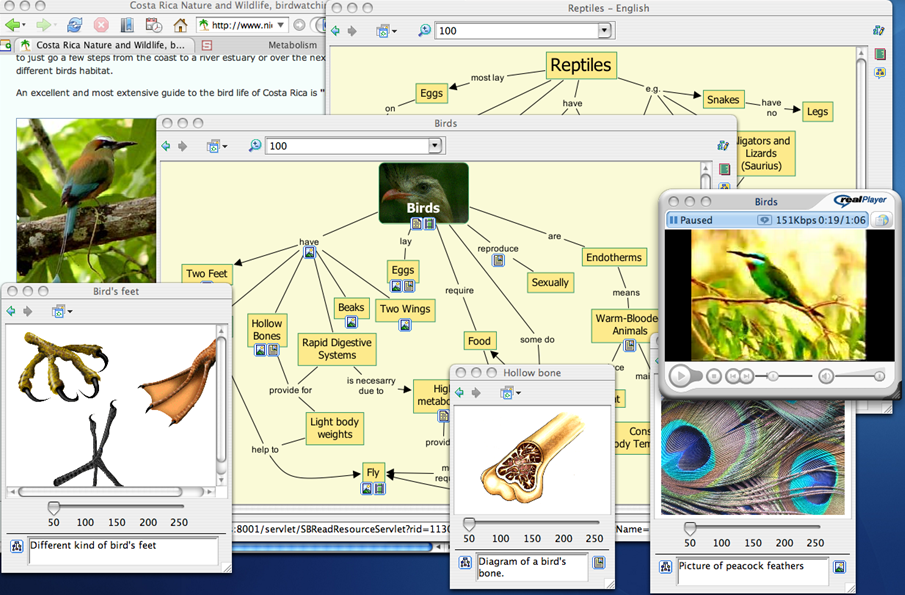
Opportunity is limited to one's imagination. Maps can use texts, images, and lines -- which can help with the overall understanding or in clarifying explaination for others. The scientific literature differentiates between mind maps and concept maps. Mind maps (or comprehension maps) are mainly useful for solving problems and for design work. Concept maps are recommended for visualizing the taxonomy within some topics. A Net structure is recommended for concept maps, while hierarchic maps are recommended for mind maps.
How are they drawn?
Drawings can be created by hand on a piece of paper or on a board. It is not necessary to use a computer. Here are a few tips and ideas to make drawing easier.
- Start drawing from the center of the page and continue by creating branches.
- Use as many images and figure as many possible for illustrating keywords.
- The center of the drawing should be visually strong (and pictorial?).
- Add words and notes on the connecting lines.
- Use different font sizes (small letters, capital letters) and colours for highlighting notes.
- Use arrows for illustrating connections.
- Do not stick to one area; if you get tired of one branch work on another.
- A Map should fit onto one A4 (letter size) sheet.
- Be creative and embrace humour!
Software drawing tools
Many software packages exist for drawing comprehesion maps, and many of them are freeware. (See: http://www.mind-mapping.org/web-based-mindmappers/summary.html ). These include:
- MindManager (commercial)
- FreeMind (freeware)
- Microsoft Visio (commercial)
Web 2.0 applications support co-operation and content sharing for designing solutions. Tenegen has trialed Mindmester and DropMind, both of which have options for inviting others to co-operate in designing maps.
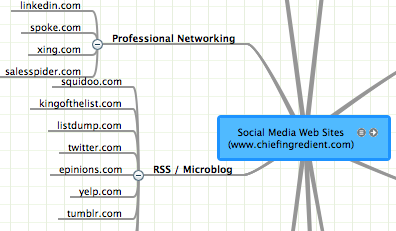 |
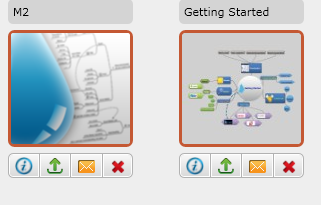 |
| MindMeister http://www.mindmeister.com |
DropMind http://www.dropmind.com |
 Exercises
Exercises
The picture below is an "embedded" Mindmeister Map which you can investigate in detail. Using the icons to the bottom of the picture you can perform various options, e.g. switch to full screen and move within the map. 1. Visit the Mindmeister website and watch its video tutorials to learn how to use it. (There is a ready-made account on the Mindmeister: user - tenegen; password - tenegen555). Try to create your own map, and write your experiences in your blog!
2. Do you think your students could be persuaded to create a comprehension map for themselves for a given topic?
3. Visit this site: http://mappio.com/ and look at the examples. Write your impressions of them in your diary, and say how you might use the examples in your own subject area.
References
1. Buzan, T. és Buzan, B.: Das Mind-Map Buch. MVG Verlag. Heidelberg, 2002
2. A COMPARATIVE SURVEY ON MIND MAPPING TOOLS
Turkish Online Journal of Distance Education-TOJDE July 2009 ISSN 1302-6488 Volume: 10 Number: 3 Article 2
3. Here is an interestingpresentation about comprehensive maps that is worth watching: http://www.slideshare.net/fredmiller/mind-mapping-copy-presentation.
4. More examples: https://www.novamind.com/cloud/doc/list
Social softwares
![]() Learning Objectives
Learning Objectives
- Discovering how easy is to create a community web page,
- Understand the concepts of “social software” and “social network”,
- Considering how this tool should be used in teaching.
 Reading
Reading
Social softwares
Let’s get acquainted with the concept of social software with the help of Wikipedia:
The definition of “Social software” from Wikipedia
Social software encompasses a range of software systems that allow users to interact and share data. This computer-mediated communication has become very popular with social sites like MySpace and Facebook, media sites like Flickr and YouTube as well as commercial sites like Amazon.com and eBay. Many of these applications share characteristics like open APIs, service-oriented design and the ability to upload data and media. The terms Web 2.0 and (for large-business applications) Enterprise 2.0 are also used to describe this style of software.
The more specific terms collaborative software and groupware are usually applied narrowly to software that enables collaborative work. Distinctions among usage of the terms "social", "trusted" and "collaborative" are in the applications or uses, not the tools themselves, although some tools are used only rarely for collaborative work.
Social software applications include communication tools and interactive tools. Communication tools typically handle the capturing, storing and presentation of communication, usually written but increasingly including audio and video as well. Interactive tools handle mediated interactions between a pair or group of users. They focus on establishing and maintaining a connection among users, facilitating the mechanics of conversation and talk.
Social Networks
"The widespread application of Internet redesigned the sort of communication era where communities are develop, survive and come to end. Online communication channels are not only able to bring several hundreds of remote acquaintances to a short distance but they can do this with unknown strangers. Contacts can be created more cheaply with more people than before. This fact enriches our concepts about communities with new meanings. (Balázs Bodo, 2007)
Communities organized on the Internet are called "social networks". Social networks can be very different according to their size and/ or goals. The most popular ones are those which are based on and organized for getting to meeting and know people (e.g. iwiw, Facebook, Linkedin, MySpace, MyVip, etc.). Another large group consists those sites which are organized according to some particular interests. These usually have less members. In several cases there isn’t a clear difference between the two since special groups of interest can be organized within meeting networks too.
This subject has a large literature background. Thousand of experts are interested in investigating the pattern and the future of virtual communities.
What is in the background of this success?
According to Barry Wellman (http://groups.chass.utoronto.ca/netlab/barry-wellman/) one of the most well known experts of internet communities (from Canada) "People connected to the Internet, are social beings, they are looking for not only information, but friendship, social supports and the feeling of belonging to soa community".
All of our students are members of one or more social networks. What makes them interested?
According to the newest surveys belonging to groups is simply the basic need of people which can be achieved more cheaply and easily via Internet so obviously those who can will use this possibility. (An old single acquaintance of mine – 76 years – a lady visits several times a day a social website http://www.donna.hu where ladies with different age give advices to each other about life stile, change recipes, look at and evaluate photo albums loaded up. She told me how happy she was when received 10-15 lovely e-mail messages from this community on her name day because usually she only receives two or three phone call on this special occasion. (One day the old lady’s computer broke down and she was despaired as she was telling me how lonely she felt herself.)
Some interesting conclusions of the subject analyses
- Many people assume that belonging to virtual communities alienates people and endangers real human relationships. People spend more time on the web than with their own family. However researches didn’t prove this.
- Members of Internet community are more willing to help each other - without expecting any return – than they are in the real life community. This incident can be explained in a way that less help can be expected from the circle of direct acquaintances. In the contrary people often get help from complete strangers from some social network. Not necessary from those who they helped before. According to statistics people have about a hundred saved phone numbers the most but they can have 200-300 acquaintances on a social network. Does it mean that people have a wider circle in a virtual environment?
- Net communities are usually more opened than real communities. This does not mean that there are no exceptions. There are some professional communities where new members can only join with the recommendations of two existing members. (According to researchers real small communities are more closed and new members are accepted harder.)
- In communities organized for sharing contents there is a strong control against “free riders”. Some people are only “consumers” without supporting the collection. They will be banned after a certain time.
Private Social Portal - Ning

In the age of web 1.0 creating a social portal needed hard development and programming. Today IT experts are only needed when completely customized social site is needed with special services and functions. Creating an average social portal is as easy as pie with web 2.0 software. It does not requires more work (maybe even less) than creating our own blogs. What are the basic services provided by a social portal?
- Member files (registration, log in, creating customized profile, list of members, recruiting members),
- Content sharing options (up loading and presenting pictures, videos, documents)
- Chat room , sending e-mails,
- Blogs, handling blogs.
One of the most well known social portal editor is Ning.
We can present in a short movie (in the video library) how a social webpage can be created in just a few minutes with Ning.
 Exercises
Exercises
1. Watch the movie below about social networks in the simple “Plain English” style of Commoncraft
2. Watch the education videos for Ning in the video library and create your own social portal. Copy the link of your portal in your progress diary.
3. Many dubious writings appear about the positive effects of social networks. Many people thinks they are even harmful and result shallow relationships tempting young people for spending their time in idleness. What do you think of it? What do you think about the pedagogical potentials of social networks? Is there such in your opinion? Enter in your progress diary.
Personalized homepage
 Learning Objectives
Learning Objectives
- Discovering the advantages of RSS,
- Creating my personal frontpage.
 Reading
Reading 
The concept and the services of personal frontpage has already been introduced in the chapter for RSS. Also get acquainted with a few direct solutions like Netvibes, iGoogle, Protopage, Widgami applications. For a practice everyone had to put on the RSS newsreader of his/her progress diary. Now you can learn how to create your own personal webpage using the application you have known in the earlies lessons, using the Netvibes.
Creating a personal webpage in a few steps
Visit the site: http://www.netvibes.com

2. Public pages can be opened from the e-mails received! Open it and enter!
3. Before starting you can check this video to get an impression about the application:
Netvibes Showcase from Netvibes on Vimeo.
4. Netvibes is going to install automatically several pages, that may be useless for you but they can be erased when clicking on the small cross next to the name of the page!5. Open the main menu!

6. From the main menu you can select from the elements already known from Netvibes: news sources, modules (widgets), RSS channels can be inserted in the page.
7. Select among the modules and click on the menu “Add to my page” from the displayed menu. When a key word is entered fresh contents can be received by the selection of the given key word.


8. In the “Adjust” menu color combinations and arrangements can be chosen. Modules can be moved by dragging at the top.

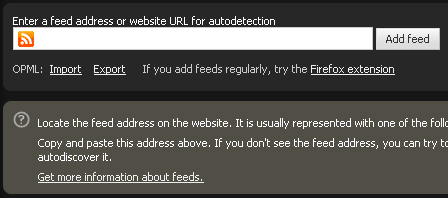
Storytelling
 Learning Objectives
Learning Objectives
When you have completed this session, you should be able to
- List some digital storytelling web 2.0 applications
- Create a digital timeline (dipity)
- Create a digital story
 Reading
Reading
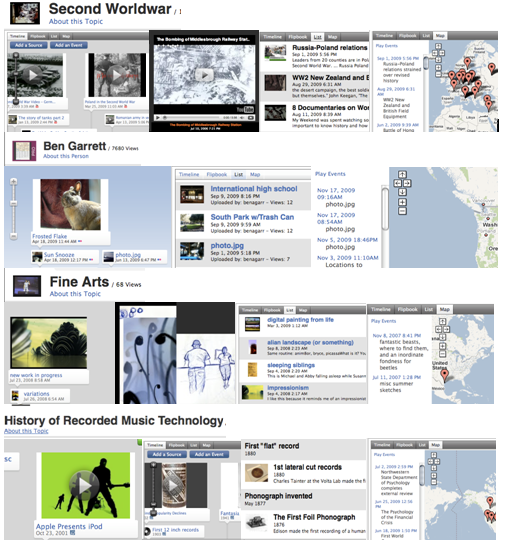 How will a story digital? What is this?
How will a story digital? What is this?
We all like tales and stories not only the kids. All the evidence shows that storytelling and tales slowly disappeared from school lessons, in misbelief that stories and pictures does not fit into scientific thinking and plays down the crystal-clear logical train of thought.
Added a Web-based publishing and content-sharing option.
Timelines - Dipity
Dipity is an online program that allows the user to create interactive timelines with events, descriptions, photos/images, URL links, etc.It allows users to work with content directly, or automatically pull highly relevant content from socially-curated sites like YouTube, Wikipedia, Digg and others using RSS and API integrations.
Once created, the interactive widget stays up-to-date, and can be embedded in blogs, social networks, and websites to add an interactive, engaging element to any site.
Elements
Place the picture, text and video elements of the events in chronological order to the time line and on the google map mark the location of events. Here are the four types of timeline views:

The first view is the timeline itself (or only a small part - of the timeline appears in the following picture), the second is a set of slides with the uploaded pictures, videos, the third is a list of events, and the fourth is the Google map marked geographic locations by events.
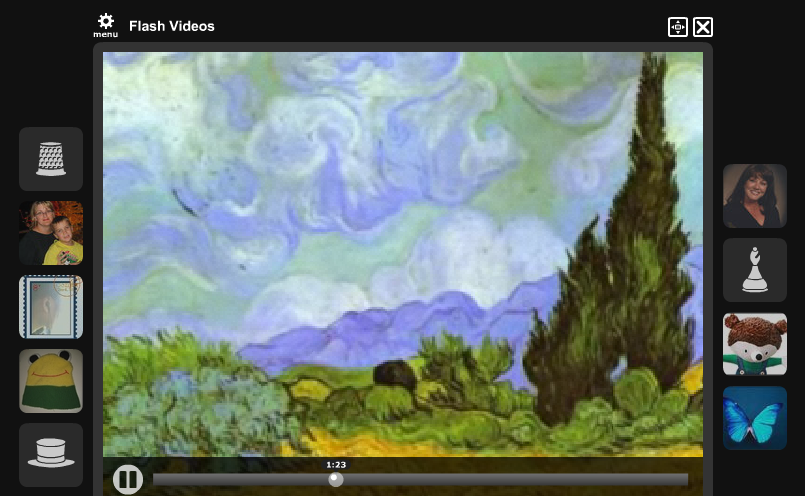 <időrendben>
<időrendben>Why is it good? The class, the children can tell their own stories. How to apply it in the several subjects - only our imagination is the limit.
VoiceThread, the another tool of digital storytelling has already been presented and tested. Both these tools have different options: strength of the Dipity is the timeline and the RSS, the specific tool of Voicethread is the opportunity to comment the story directly, and it has comic appearance. The picture shows a Voicethread story with Flash animation backgrounds: http://voicethread.com/#q.b13870.i102798
What is the most important message for us of the digital presentation (Plain English): the focus is on whether we can involve and how we can involve the child in the preparation of web production! This is perhaps a little support to art education as well.
Timeline applications:
http://blog.xtimeline.com/, http://www.timetoast.com/
http://www.dipity.com
 Exercises
Exercises
1. Visit the site Dipity TeNeGen story! (You can find a very secret video as XXXX:))!
3. Registrate on VoiceThread site, and create a small story with some pictures.
References
How to use Voicethread: http://digitallyspeaking.pbworks.com/w/page/17791585/Voicethread
Copy the links into your learning diary.
Tenegen story
 The Third Web 2.0 Tool
The Third Web 2.0 Tool
 Special diashows can be created from the uploaded pictures for visitors. It becomes a real story with the notes added!
|
Proof of the pudding...
In order to read (listen or watch) the first comment click on the mini on the left of the screen or the play button in the picture.
However it is important to know that these errors appear in formulas embedded (in other webpages)! If you have problems with the characters or with the registartion work in original application! (Comments added there appear in the embedded section after refreshing.
Clicking on this link you can find the original one! We are waiting for your further notes!
Microphone is needed for audio comments and camera for "video phoning".
 Exercises
Exercises
1. What is your experience? Could you imagine a class "telling stories"? Write your notes in your progress diary!
2. For English teachers! How would you translate to your language the words "VoiceThread" and "Protopage"?
Creative Commons
New teaching roles
The old “new pedagogy”
The era of information society is not the first one when the importance of students’ activity arose. Good teachers always knew exactly how important is not letting students be only the passive participants of lessons.
According to the constructivist approach learning is creative process and its effectiveness depends on one hand on the personal talents of students and on the other hand on the environment. Knowledge is a result of social cooperation developed in interaction with the environment. Teachers are not responsible for giving new knowledge but for supporting student in “building up” their knowledge.
According to the objectivist approach knowledge and the abilities needed for solving a given problem can be exactly (objectively) determined . This precisely defined “knowledge pack” can be handed over to another persons as a finished product, who as a simple receiver, do not have to make any special activity or effort.
Teachers with objectivist approach:
- summarizes knowledge in his/her presentations (assembles knowledge packs);
- presents facts and logical coherences;
- illustrates how problems or tasks can be solved with the knowledge pack;
- gives practicing exercises and evaluates the results.
Teachers with constructivist approach:
- start with raising problems with examples and situations;
- help students find the solutions, have students “discover” the method;
- organize, complement and summarize thoughts upcoming during the solution process.
Teaching with objectivist approach is simpler from the teaching point of view and requires less investment but there is a high risk of providing unrealistic and less useful knowledge. Students enrolled from secondary schools to universities and not knowing how to calculate percentage (even with calculators) possibly have this kind of educational background.
|
Certainly constructivist teaching cannot be applied always in every situation. In some cases “knowledge packs” must be provided and it is justified in higher education. However good teachers know exactly in what ratio these two methods should be applied. |
Problem focusing tendency is getting more and more emphasized though as a pedagogical trend it is not new at all. It appeared in reform-pedagogy at the beginning of the 20th century. [1] . In this approach problems selected according to students’ needs (suitable for the features of age and individual environment) are put in the focus of the teaching / learning process . According to the method passing any knowledge should be started with the upraising of such problems (examples) which are interesting for students and have some importance therefore suitable for raising interest. Learning is not just mediating knowledge but a process with students standing in the middle. According to this tendency we do not simply talk about learning but learning environment (this is what Dewey mentioned in the beginning of the 19th century – see the extract!) wherein:
- students participate actively;
- teachers are not present as autocrats but as mentors and tutors;
- knowledge is developed in cooperation and interactions as a result of social environment.
[1] The “discovering” problem solving method is described by the Hungarian mathematician and physicist György Pólya in his world famous book: The School of Thinking.
While in the 20th century teachers are monopolists of knowledge in the 21st century they are mates “learning managers” who can help with his or her profession finding the way in the mass information.
The importance of student centered approach is being formulated again and again but the realization takes little progress and is getting ahead very slowly. The possible explanation of this problem is that developing practical, life like teaching / learning environment means an immense task for teachers.
The characteristics of educational systems in the industrial society are the following:
- publication of facts, data, rules;
- passing closed, finite, book standard knowledge;
- homogeneous group learning;
- frontal teaching, presentation.
Requirements in the informal society:
- developing abilities and competences;
- preparation for life long learning;
- personalized learning environment, heterogeneous groups;
- constructivist approach, application of collaborative methods.
The objectives of education:
- preparing for constant learning;
- intelligent learning;
- knowledge of digital writing;
- problem solving skills;
- communication skills;
- developing social and life management skills.
What should (must) we the teachers give up? That we only present and check lessons. As parents (and as former students) we know exactly what an autocratic all-powerful teacher character means in shaping our children’s (and what it meant in our own) fate.
The environment in information society makes impossible objectivist, autocratic teacher mentality. Teachers of the 21st century by keeping leadership – not as being the only owners of knowledge – must be present in the learning environment as learning motivating mentors and facilitators [2] .
[2] The duties of facilitators are known from round table talks, usually participated by several experts with the aim of analyzing and overview jointly a definite problem and building a common standpoint. The duties of facilitators are to guide these talking the way participants should not digress from the given subject.
While teaching he/she continuously learns as well and is able to handle the situation when some students are ahead of him or her. Teachers must learn to use all the possibilities that network communication and IT technology can potentially provide:
- able to access the newest information fast and cheaply;
- there are no barriers of continuous professional developments;
- almost unlimited possibilities of professional cooperation.
Hopefully as IT tools become a part of education the burdens of administration become less and we can use these possibilities.
References
Komenczi Bertalan: Tanári szerepek és tanári kompetenciák elektronikus tanulási környezetben, 2006
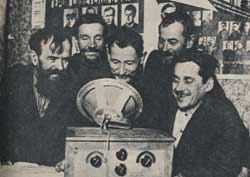 Communication between people was revolutionized by the innovations of late 19th and early 20th century such as the telegraph, telephone, radio, and television. The foundation for these innovations was provided by scientific results in the area of magnetic science and electricity.
Communication between people was revolutionized by the innovations of late 19th and early 20th century such as the telegraph, telephone, radio, and television. The foundation for these innovations was provided by scientific results in the area of magnetic science and electricity.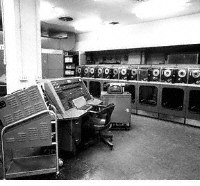 The principles of the logical structure of electronic computer appliances by János Neumann (1903–1957), Goldstein and Burks was published in 1946. The first stored program-controlled computer – the UNIVAC (1951) – was built according to their ideas, and was created for market sale, not a specific need.
The principles of the logical structure of electronic computer appliances by János Neumann (1903–1957), Goldstein and Burks was published in 1946. The first stored program-controlled computer – the UNIVAC (1951) – was built according to their ideas, and was created for market sale, not a specific need. The first transistor was invented at Bell Laboratories in 1947. With the application of transistors and ferric rings the so called second generation computers were created with a much smaller size and remarkably less heating problems as their predecessors, while at the same time being much faster and with a storage capacity improved by magnitudes.
The first transistor was invented at Bell Laboratories in 1947. With the application of transistors and ferric rings the so called second generation computers were created with a much smaller size and remarkably less heating problems as their predecessors, while at the same time being much faster and with a storage capacity improved by magnitudes. 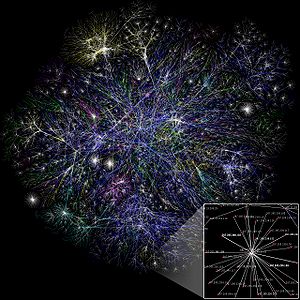 The immense ‘info-communication leap’ was the development of computer networks in the 70s.
The immense ‘info-communication leap’ was the development of computer networks in the 70s. The hardware support that makes it possible to send, read, listen to digitized multimedia information (images, video, audio) to/from any part of the world quickly and with high quality relies on multimedia technologies.
The hardware support that makes it possible to send, read, listen to digitized multimedia information (images, video, audio) to/from any part of the world quickly and with high quality relies on multimedia technologies.